Forced Convection Drying Oven
A forced convection drying oven is a type of drying equipment that utilizes a fan or blower to circulate heated air within the oven chamber, facilitating faster and more efficient drying of materials. The forced convection mechanism ensures uniform heat distribution, reducing drying times and improving overall drying performance.
Here are some key features and benefits of a forced convection drying oven:
Heating System: A forced convection drying oven typically uses electric heating elements to generate heat. The heating elements are strategically placed within the oven chamber to ensure even heat distribution.
Air Circulation: The oven is equipped with a fan or blower that continuously circulates heated air throughout the chamber. The circulating air helps to remove moisture from the materials being dried and ensures uniform temperature distribution, resulting in more consistent drying.
Temperature Control: Forced convection drying ovens usually feature precise temperature control mechanisms. They may incorporate digital temperature controllers or programmable controllers to maintain a desired temperature throughout the drying process.
Adjustable Airflow: Some models of forced convection drying ovens allow users to adjust the airflow rate. This feature provides flexibility in optimizing the drying conditions for different materials or specific drying requirements.
Faster Drying: The forced convection mechanism in these ovens promotes faster and more efficient drying compared to natural convection ovens. The continuous circulation of heated air enhances heat transfer to the materials, accelerating the drying process.
Uniform Drying: The even distribution of heated air within the oven chamber ensures uniform drying across all parts of the materials being dried. This feature is particularly advantageous when drying larger quantities or bulky items.
Versatility: Forced convection drying ovens are suitable for a wide range of applications across various industries. They can be used for drying, curing, sterilizing, or heat treatment processes in fields such as pharmaceuticals, electronics, materials research, food production, and more.
Safety Features: These ovens often incorporate safety features such as over-temperature protection, alarms, and safety interlocks to prevent overheating or potential hazards.
Forced convection drying ovens offer efficient and reliable drying capabilities, making them valuable tools in many industries and laboratories. The combination of controlled airflow and uniform heat distribution enables faster and more consistent drying of a wide range of materials, leading to improved productivity and quality.
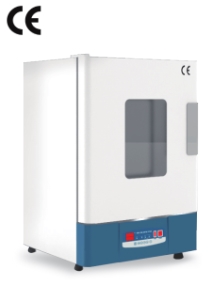
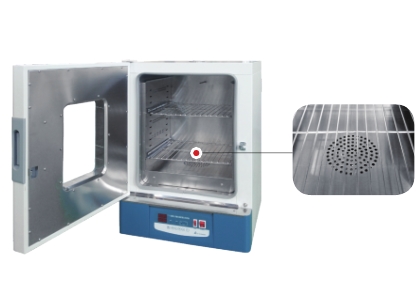

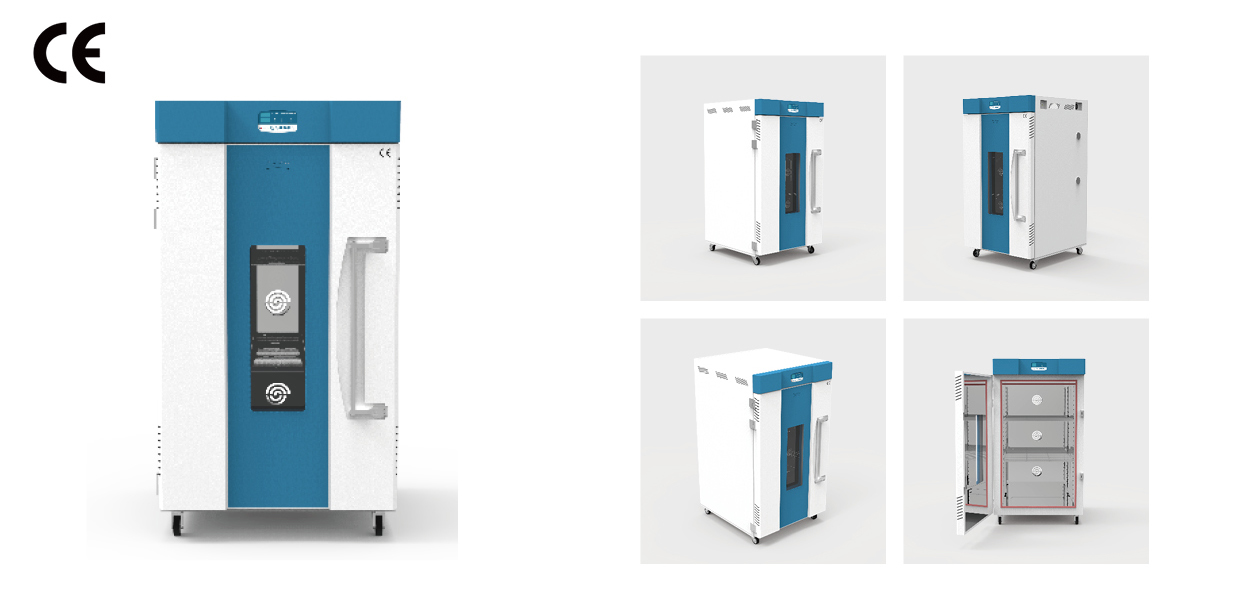
Forced Convection Drying Oven
- With TurboFan and ON/OFF function.
- Internal observation is possible through the viewing window
- Stainless Steel Internal Chamber with shelves
- Excellent temperature uniformity and accuracy
Forced Convection Drying Oven Feature
Forced Convection Drying Oven is commonly used in laboratories and other related industries for the purpose of sample drying and sterilization. It also comes with outstanding features such as high level of temp. uniformity, precise accuracy and stable temperature control. All of these are possible through our advanced technology and continuous innovation.
- Digital PID controller
- Surface finished stainless steel
- Powder coated steel plate
- Leveling feet
- Safety devices
- User friendly door handle

350°C Drying Oven
A 350°C drying oven refers to a specific type of oven that is designed to operate at temperatures up to 350 degrees Celsius. These ovens are commonly used for various drying, curing, or heat treatment processes that require elevated temperatures.
Here are some key features and considerations related to a 350°C drying oven:
Temperature Range: A 350°C drying oven can reach and maintain temperatures up to 350 degrees Celsius (or 662 degrees Fahrenheit). The ability to achieve and sustain high temperatures makes it suitable for applications that involve drying or heat treatment of materials requiring elevated temperatures.
Heating System: These ovens typically utilize electric heating elements, such as resistive heating coils, to generate and distribute heat throughout the oven chamber. The heating elements are designed to provide even heat distribution for uniform drying.
Temperature Control: A 350°C drying oven is equipped with a temperature control system to accurately regulate and maintain the desired temperature. This may include digital controllers, programmable temperature profiles, or PID (Proportional-Integral-Derivative) control systems.
Chamber Design: The oven chamber is constructed to withstand high temperatures and may be made of materials such as stainless steel or heat-resistant alloys. It is essential to ensure that the materials being processed are compatible with the chamber construction and temperature capabilities of the oven.
Ventilation: Adequate ventilation or exhaust systems may be incorporated to remove any fumes, gases, or byproducts generated during the drying process. This helps maintain a safe and controlled working environment.
Safety Considerations: Working with high temperatures requires adherence to safety guidelines. A 350°C drying oven should include safety features such as over-temperature protection, safety interlocks, and insulation to minimize heat loss and prevent potential hazards.
Applications: A 350°C drying oven finds application in various industries, including electronics, materials research, pharmaceuticals, food production, and more. It can be used for drying, curing, sterilization, heat treatment, or other processes that require high-temperature environments.
It is important to follow the manufacturer's instructions and guidelines for safe operation and maintenance of the 350°C drying oven. Additionally, consider the specific requirements and limitations of the materials being processed to ensure optimal drying outcomes and equipment longevity.
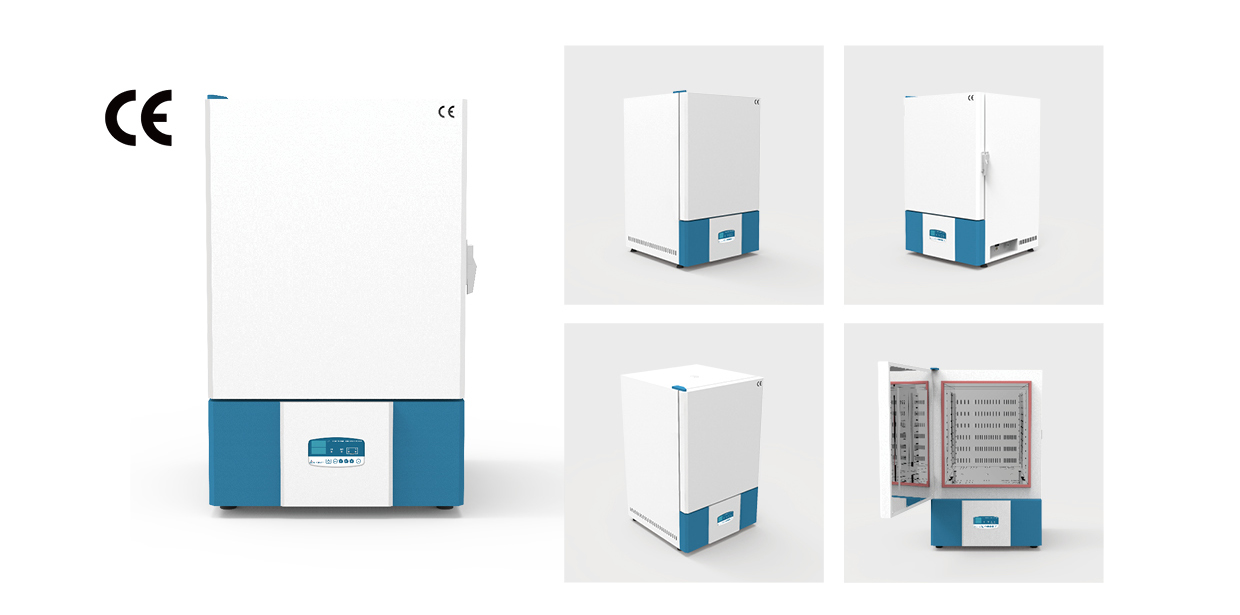
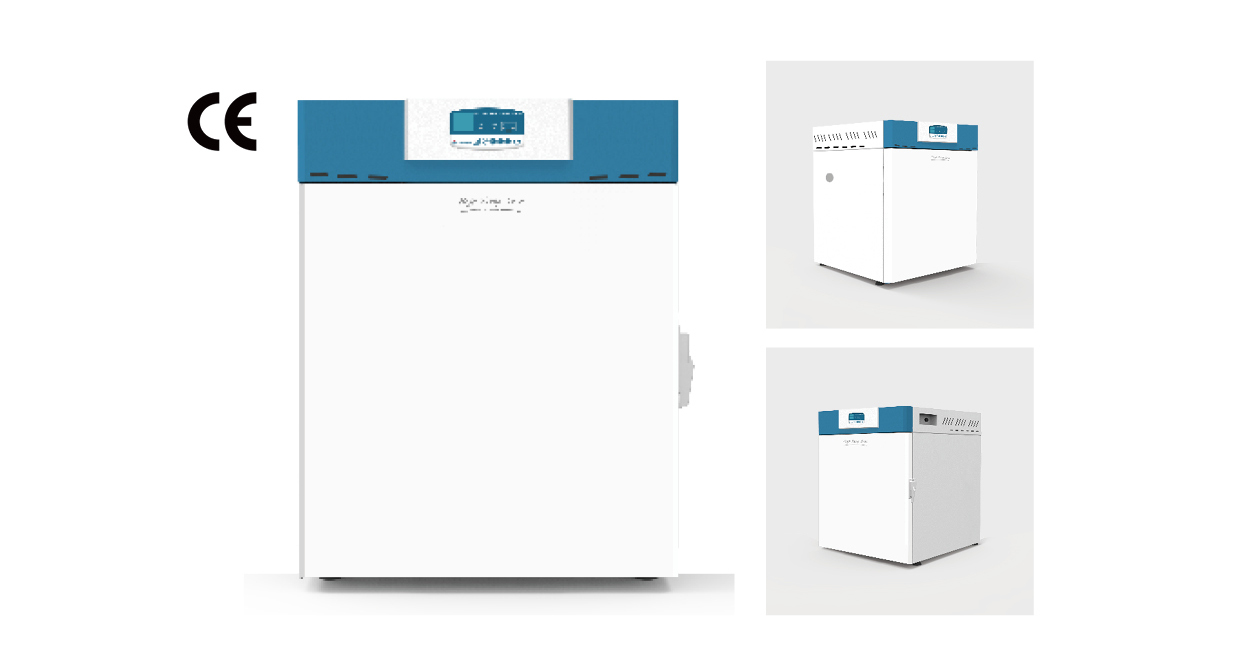
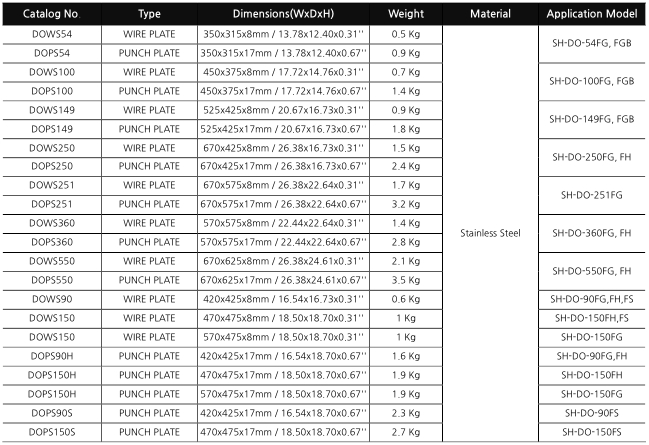
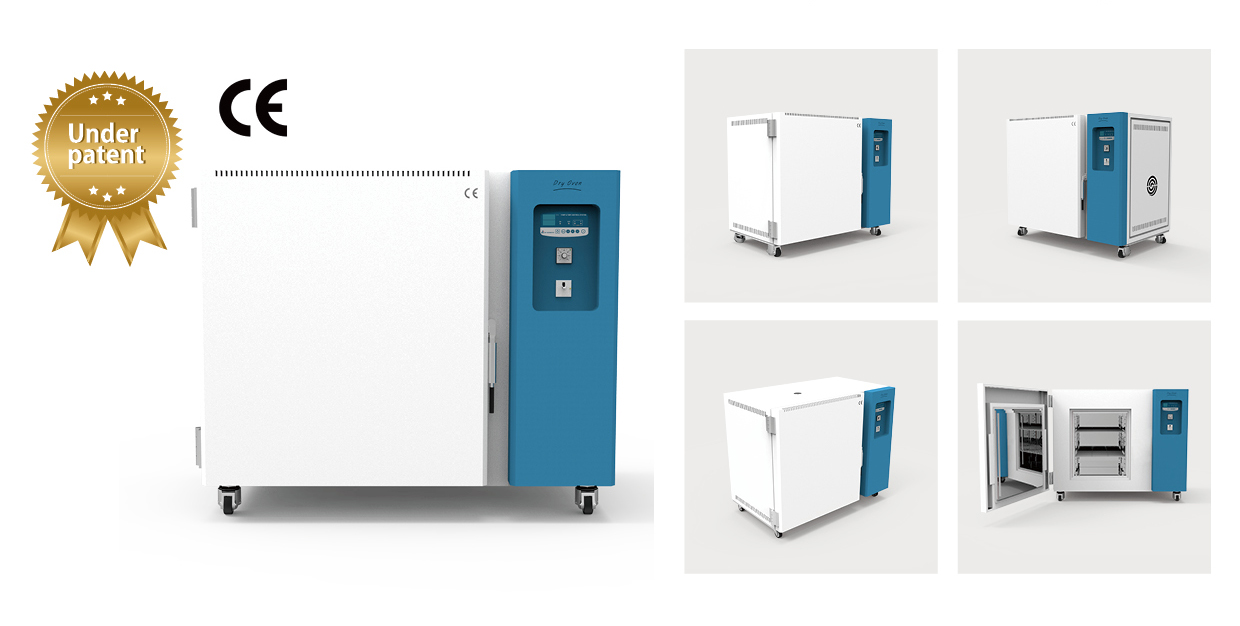
Drying Oven with Air Filter
A drying oven with an air filter is a type of oven that incorporates a filtration system to ensure clean and filtered air is circulated within the oven chamber during the drying process. The air filter helps to remove contaminants, particles, or airborne impurities, providing a cleaner and controlled drying environment. This feature is particularly useful when working with sensitive materials or when maintaining a specific level of cleanliness is essential.
Here are some key features and benefits of a drying oven with an air filter:
Filtration System: The oven is equipped with an air filtration system, which typically includes filters such as HEPA (High-Efficiency Particulate Air) filters or activated carbon filters. These filters capture and remove contaminants, dust, particles, or volatile organic compounds (VOCs) from the air circulating within the oven chamber.
Clean and Controlled Environment: The air filter ensures that the air used for drying is clean and free from potentially harmful or unwanted particles. This helps to maintain a controlled environment and minimize the risk of contamination or adverse effects on the drying process or the materials being dried.
Improved Product Quality: By filtering the air, the oven helps to prevent particles or impurities from settling on the drying materials, resulting in improved product quality. This is especially important when working with sensitive or precision components, electronics, pharmaceuticals, or other materials where cleanliness is critical.
Protection of Oven Components: The air filter helps to protect the internal components of the oven, such as heating elements or fans, by preventing the accumulation of dust or debris that could interfere with their performance or lifespan.
User Safety: The filtration system in the oven contributes to a safer working environment by reducing the inhalation of potentially harmful airborne particles or fumes generated during the drying process.
Customizable Filtration Options: Depending on the specific requirements, drying ovens with air filters may offer different types of filters or customizable filter options. This allows users to select filters that best suit their application, such as HEPA filters for particle removal or activated carbon filters for VOC removal.
It's important to regularly maintain and replace the air filters in the oven according to the manufacturer's guidelines to ensure optimal filtration efficiency and performance. The filtration system should be checked, cleaned, or replaced as needed to maintain the desired level of air cleanliness and quality during the drying process.
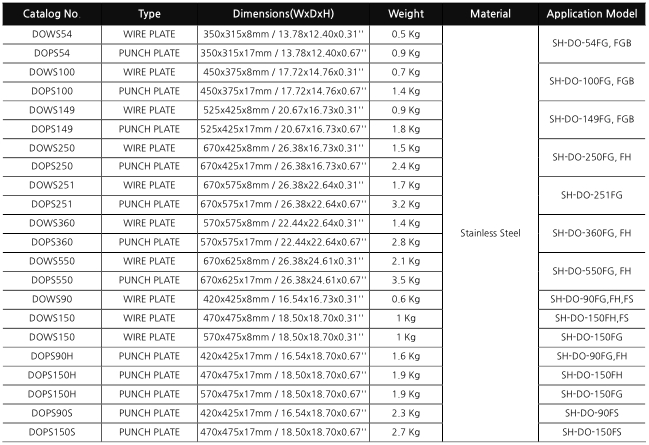
500°C Drying Oven
A 500°C drying oven is a specialized type of oven that is designed to operate at temperatures up to 500 degrees Celsius. These high-temperature ovens are used for drying, curing, heat treatment, or other processes that require extreme heat.
Here are some key features and considerations related to a 500°C drying oven:
Temperature Range: A 500°C drying oven can reach and maintain temperatures up to 500 degrees Celsius (or 932 degrees Fahrenheit). The ability to achieve and sustain such high temperatures makes it suitable for applications that involve drying or heat treatment of materials that require extremely elevated temperatures.
Heating System: These ovens typically use powerful electric heating elements, such as resistive heating coils or high-temperature heating elements, to generate and distribute heat throughout the oven chamber. The heating system is designed to provide efficient and uniform heat transfer for optimal drying results.
Temperature Control: A 500°C drying oven is equipped with a sophisticated temperature control system to accurately regulate and maintain the desired high temperature. Advanced temperature controllers, PID control systems, or programmable temperature profiles may be incorporated to ensure precise temperature control.
Chamber Design: The oven chamber is constructed with materials that can withstand and retain high temperatures, such as stainless steel, heat-resistant alloys, or ceramic materials. The chamber design should provide insulation and temperature uniformity for consistent and efficient drying.
Ventilation: Adequate ventilation or exhaust systems are essential in high-temperature ovens to remove any fumes, gases, or byproducts generated during the drying process. These ventilation systems help maintain a safe and controlled working environment.
Safety Considerations: Working with extremely high temperatures requires strict adherence to safety guidelines. A 500°C drying oven should incorporate advanced safety features such as over-temperature protection, safety interlocks, insulation, and appropriate ventilation to minimize heat loss and prevent potential hazards.
Applications: A 500°C drying oven finds application in specialized industries and research fields that require extreme heat for drying or heat treatment processes. These may include advanced materials research, metallurgy, ceramics, semiconductor manufacturing, aerospace, or any industry dealing with heat-resistant materials.
It is crucial to follow the manufacturer's instructions, safety guidelines, and best practices for operating and maintaining a 500°C drying oven. Additionally, consider the specific requirements and limitations of the materials being processed to ensure optimal drying outcomes, equipment longevity, and user safety.
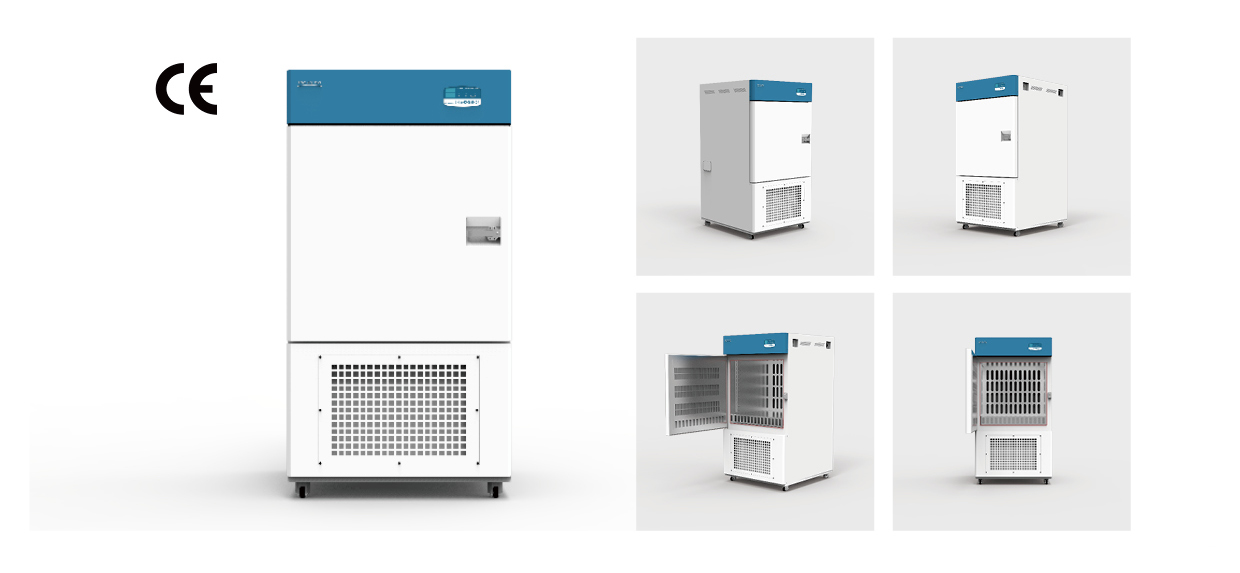

Industrial Drying Oven
An industrial drying oven is a large-scale oven specifically designed for industrial applications that require drying, curing, or heat treatment processes on a larger or bulkier scale. These ovens are used in various industries, such as manufacturing, food processing, pharmaceuticals, electronics, automotive, and more. Industrial drying ovens are known for their robust construction, higher capacities, and advanced features to meet the demanding requirements of industrial production environments.
Here are some key features and considerations related to industrial drying ovens:
Size and Capacity: Industrial drying ovens are typically larger in size compared to laboratory or smaller-scale ovens. They come in various sizes and configurations to accommodate larger volumes of materials or bigger components. The capacity of an industrial drying oven can range from a few cubic feet to several thousand cubic feet, depending on the application.
Temperature Range: Industrial drying ovens offer a wide temperature range to accommodate different drying or heat treatment requirements. They can typically achieve and maintain temperatures ranging from ambient temperatures to several hundred degrees Celsius, depending on the specific model and application.
Construction and Insulation: Industrial drying ovens are built with sturdy materials such as stainless steel or heavy-gauge steel to withstand the demands of industrial environments. They often feature robust insulation to minimize heat loss and improve energy efficiency. Insulation materials can include ceramic fiber, mineral wool, or high-temperature insulation materials.
Heating System: These ovens utilize powerful heating systems to generate and distribute heat within the oven chamber. Common heating methods include electric heating elements, gas burners, or infrared heating systems, depending on the specific application and requirements.
Air Circulation: Industrial drying ovens employ forced convection or recirculation systems to ensure uniform heat distribution and efficient drying. They may include powerful fans or blowers to facilitate airflow and improve heat transfer, ensuring consistent drying across the entire oven chamber.
Temperature Control and Monitoring: Industrial drying ovens feature advanced temperature control systems to accurately regulate and maintain the desired temperature. These can include digital temperature controllers, programmable controllers, or computerized control systems. Additionally, they may have temperature monitoring capabilities for data logging or process control purposes.
Safety Features: Industrial drying ovens incorporate various safety features, such as over-temperature protection, safety interlocks, and alarm systems. These features help to ensure operator safety and prevent potential hazards or equipment damage.
Customization and Integration: Industrial drying ovens can be customized to suit specific process requirements, such as incorporating conveyor systems for continuous drying, integrating PLC (Programmable Logic Controller) for automation, or adapting to specific material handling needs.
Compliance and Certifications: Industrial drying ovens may adhere to industry standards and certifications, depending on the application or industry. These certifications can include ISO, CE, UL, or other relevant standards to ensure compliance with safety and quality regulations.
Industrial drying ovens are essential for large-scale drying or heat treatment processes in various industrial sectors. Their robust construction, high capacity, advanced features, and customization options make them suitable for demanding industrial applications where consistent and efficient drying is required.

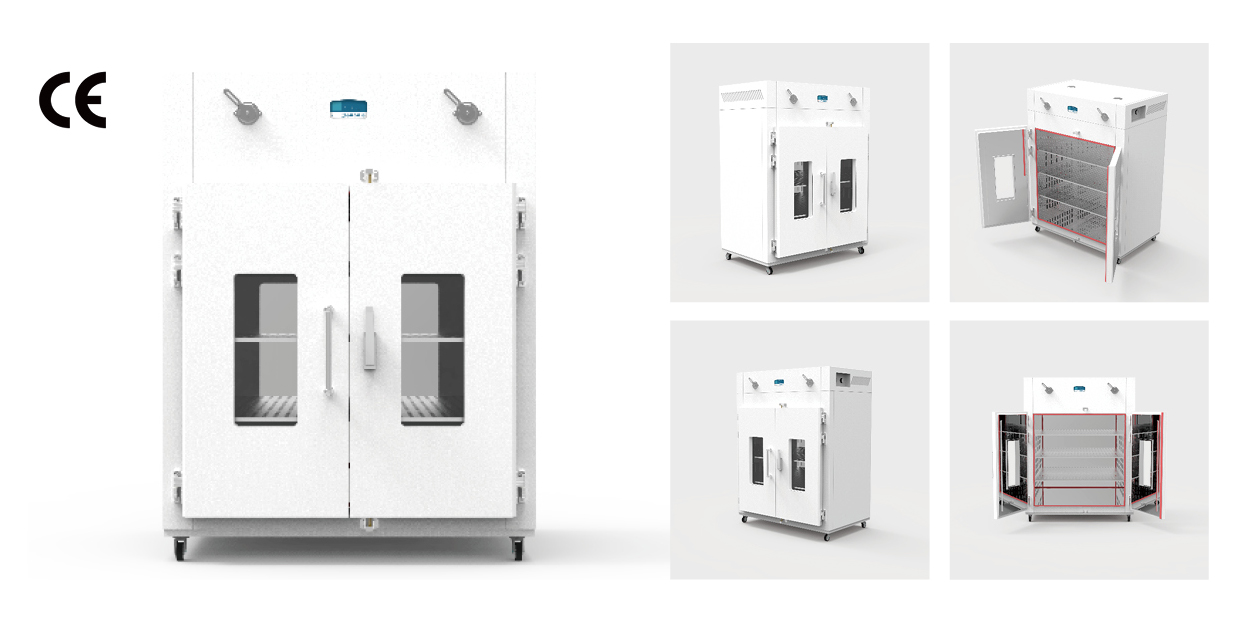
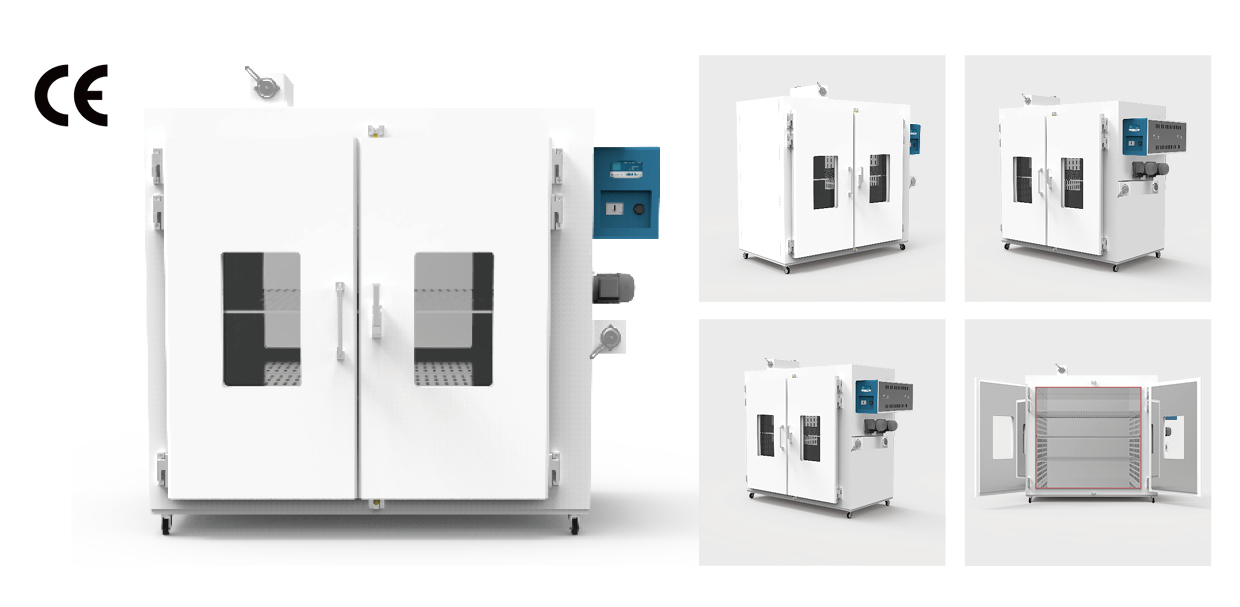

300°C Industrial Drying Oven
A 300°C industrial drying oven is a specific type of industrial oven designed to operate at temperatures up to 300 degrees Celsius. These ovens are commonly used in industrial applications where materials or products require drying, curing, or heat treatment at elevated temperatures.
Here are some key features and considerations related to a 300°C industrial drying oven:
Temperature Range: A 300°C industrial drying oven can reach and maintain temperatures up to 300 degrees Celsius (or 572 degrees Fahrenheit). The ability to achieve and sustain high temperatures makes it suitable for applications that involve drying or heat treatment of materials that require elevated temperatures.
Construction: Industrial drying ovens are constructed with sturdy materials to withstand the demands of industrial environments. The oven chamber is typically made of stainless steel or heavy-gauge steel, which provides durability and resistance to high temperatures.
Heating System: These ovens utilize powerful heating systems to generate and distribute heat within the oven chamber. Common heating methods include electric heating elements, gas burners, or infrared heating systems. The heating system is designed to provide efficient and uniform heat transfer for optimal drying results.
Temperature Control: A 300°C industrial drying oven is equipped with a temperature control system to accurately regulate and maintain the desired temperature. Advanced temperature controllers, programmable controllers, or computerized control systems may be used to ensure precise temperature control.
Air Circulation: Industrial drying ovens employ forced convection or recirculation systems to ensure uniform heat distribution and efficient drying. They may include powerful fans or blowers to facilitate airflow and improve heat transfer, ensuring consistent drying across the entire oven chamber.
Safety Features: Industrial drying ovens incorporate various safety features to ensure operator safety and prevent potential hazards. These features can include over-temperature protection, safety interlocks, door locks, and alarms.
Capacity: Industrial drying ovens come in various sizes and configurations to accommodate different production requirements. The capacity of an industrial drying oven can range from smaller units suitable for laboratory-scale operations to large-scale ovens capable of handling bulk quantities or larger components.
Applications: A 300°C industrial drying oven finds application in various industries, including manufacturing, electronics, automotive, aerospace, and more. It can be used for drying coatings, curing adhesives, heat treatment of metal parts, or any process that requires controlled and elevated temperatures.
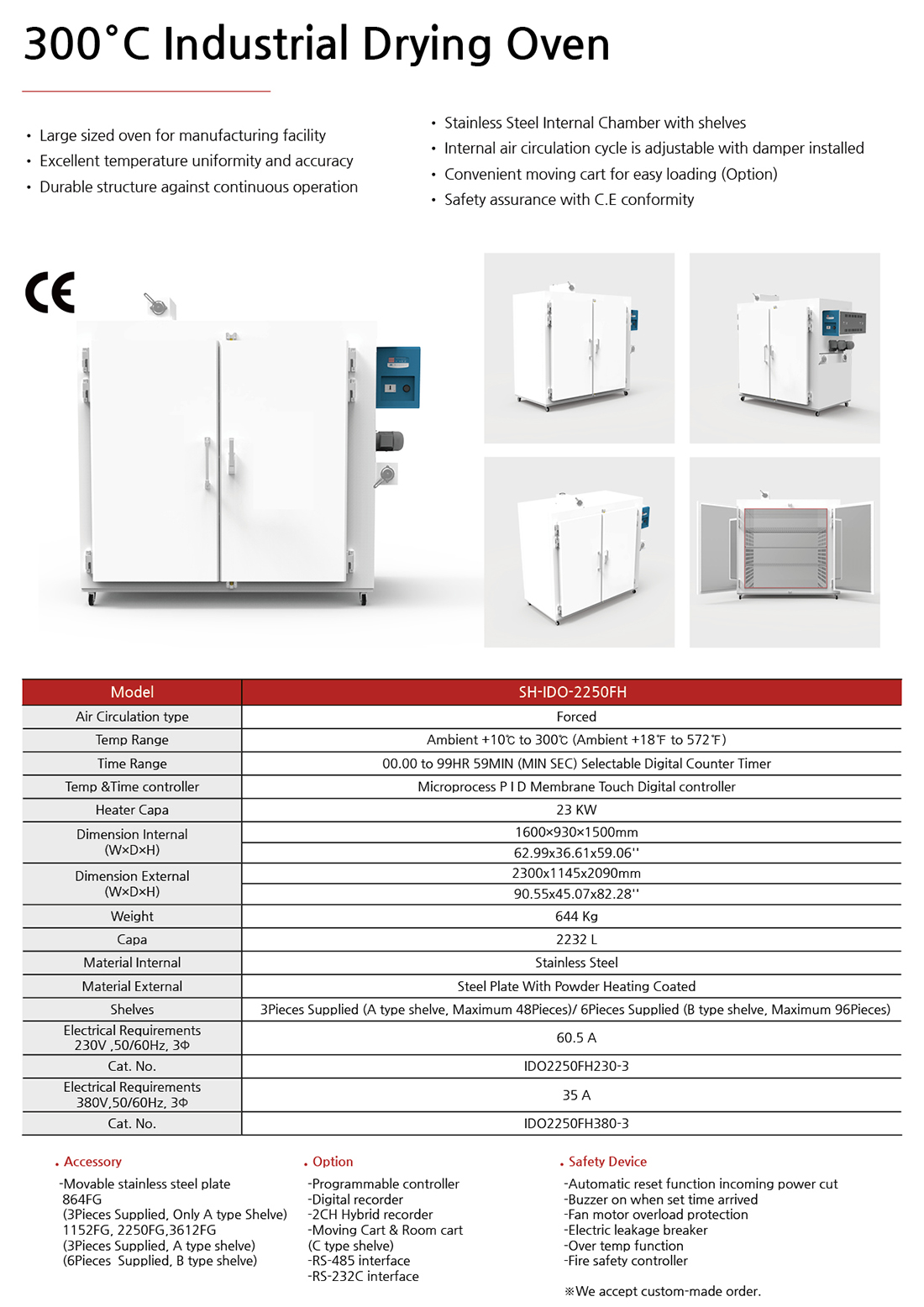

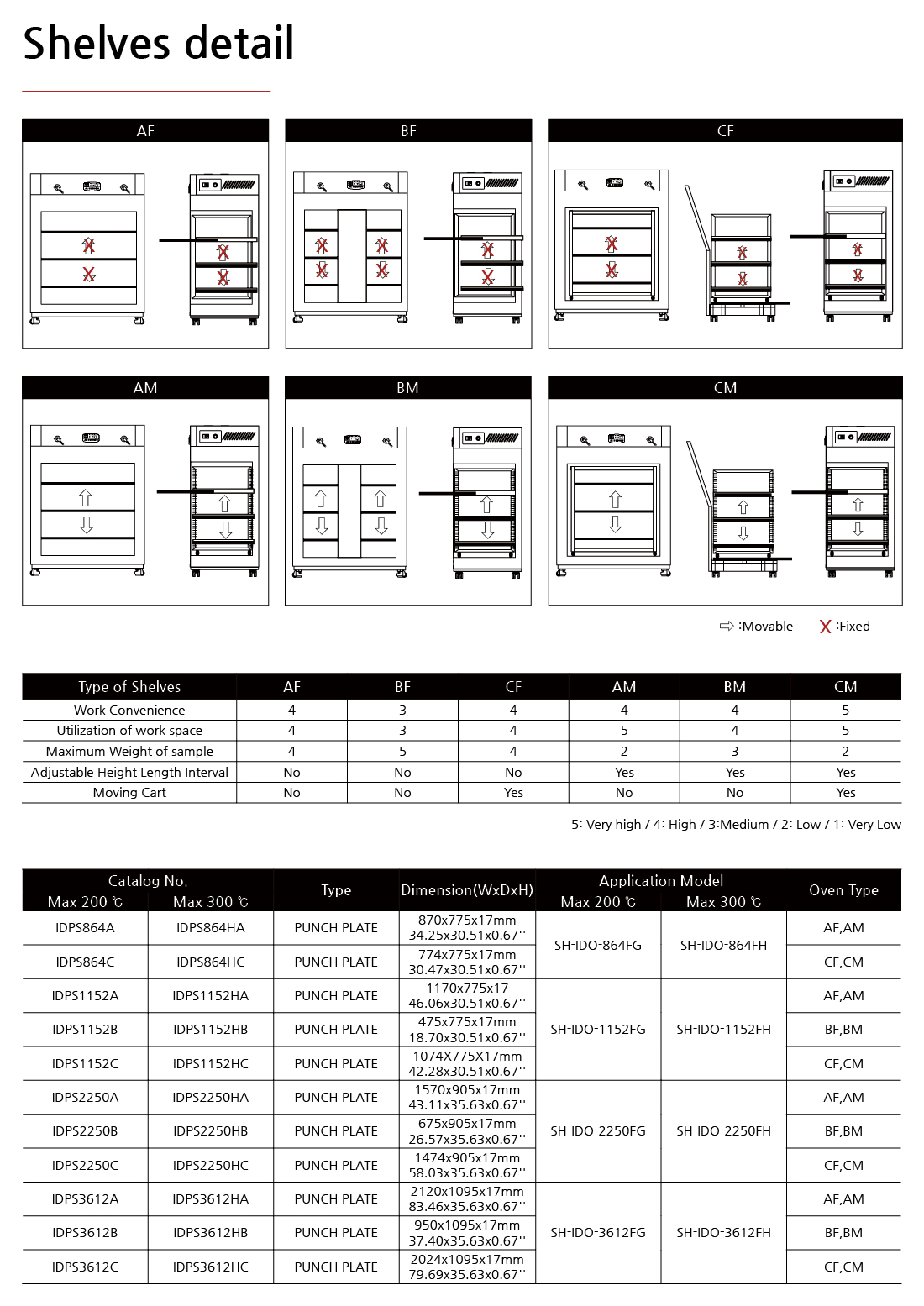
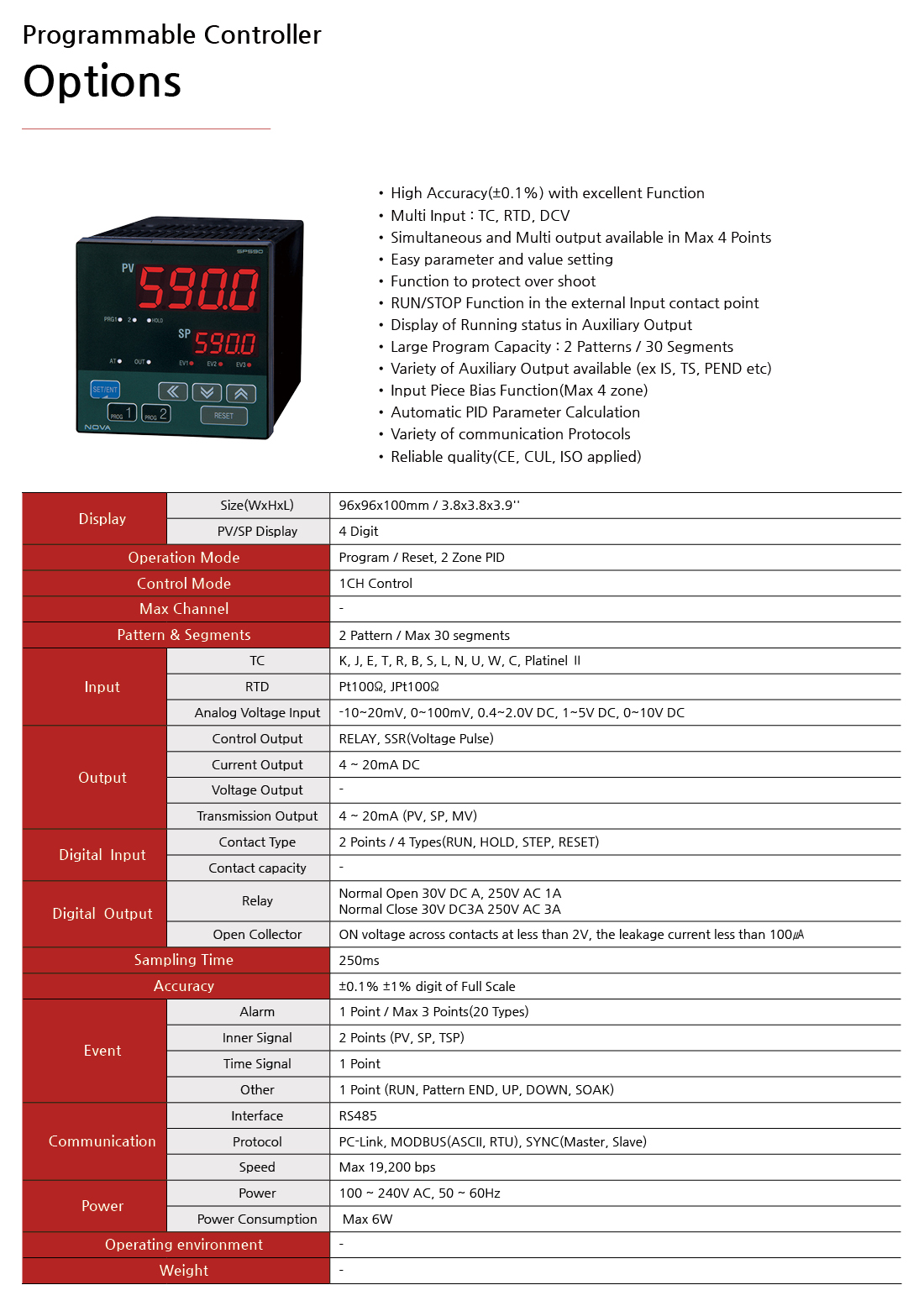
Gravity incubator
A gravity convection general incubator is a specific type of incubator used in scientific and research laboratories. It is designed to provide a stable and controlled environment for a wide range of applications, such as cell culture, microbiology, biochemical assays, and general sample incubation.
The term "gravity convection" refers to the method of heat distribution within the incubator. In a gravity convection incubator, the temperature is achieved by natural convection, where heat rises due to density differences within the chamber. There is no forced air circulation or fan system involved in the heating process. This type of incubator is known for its gentle and uniform heat distribution, making it suitable for applications that require minimal air movement, such as culturing delicate cells or maintaining stable conditions for certain experiments.
Here are some key features and characteristics commonly associated with gravity convection general incubators:
Temperature Control: Gravity convection incubators typically have precise temperature control systems that allow users to set and maintain the desired temperature accurately. They often offer a wide temperature range, typically from ambient temperature to around 70-80°C, depending on the specific model.
Chamber Design: These incubators usually have a well-insulated chamber with minimal air leakage to maintain temperature stability. The interior is often made of stainless steel or other durable materials that are easy to clean and resistant to corrosion.
Uniformity and Stability: Gravity convection incubators strive to achieve consistent temperature distribution throughout the chamber, ensuring uniform conditions for samples placed at different locations within the incubator. Stability in temperature control is crucial for maintaining the integrity and reliability of experiments and cultures.
Safety Features: Depending on the model and manufacturer, gravity convection incubators may include safety features such as over-temperature protection, alarms, and sometimes even backup systems to prevent temperature fluctuations and ensure the safety of samples and experiments.
Gravity Convection General Incubator Feature
Incubator is a basic lab equipment suitable for stagnant incubation and storage of tests requiring a specific range of temperatures for a specific period of time. In accordance to this, our incubator can maintain a uniform range of temperatures for a certain set period.
- Stainless steel inner chamber- Digital PID controller
- Inner glass door
- Powder coated steel plate
- Comfortable display at eye level
- Safety devices


Refrigerated Incubator
A refrigerated incubator, also known as a cooled incubator or low-temperature incubator, is a specialized type of incubator that combines the functions of maintaining a controlled temperature environment with the capability to cool the internal chamber to below ambient temperatures. These incubators are commonly used in research laboratories, pharmaceutical industries, and other scientific settings where temperature-sensitive samples or experiments need to be incubated at specific temperature ranges, including both above and below room temperature.
Here are some key features and characteristics of refrigerated incubators:
Temperature Range: Refrigerated incubators typically offer a broad temperature range, allowing precise control within a specific temperature range. They can cool down to temperatures as low as -10°C or even lower, depending on the model and manufacturer. Additionally, they can maintain temperatures above ambient, typically up to around 70-80°C.
Temperature Control and Stability: Refrigerated incubators have advanced temperature control systems that enable accurate and stable temperature regulation. They often feature microprocessor-based controllers or programmable temperature profiles, allowing users to set and maintain the desired temperature with high precision. Stability is crucial in refrigerated incubators to ensure the integrity of samples and the reliability of experiments.
Refrigeration System: These incubators incorporate a refrigeration system to lower the temperature within the chamber. The refrigeration system may involve mechanisms such as compressors, refrigerant gases, and cooling coils to remove heat from the internal environment. The cooling mechanism is typically supported by insulation and well-sealed chambers to minimize temperature fluctuations and ensure efficient cooling performance.
Interior Design and Capacity: Refrigerated incubators generally have a well-insulated chamber made of materials like stainless steel or other durable and easy-to-clean materials. They often offer adjustable shelving or racks to accommodate different sample containers or trays. The interior capacity can vary across models, with options available to suit various research or industrial needs.
Additional Features: Depending on the model, refrigerated incubators may come with additional features such as humidity control, programmable lighting, built-in data logging capabilities, and alarms for temperature deviations or power failures. These features can enhance the versatility and functionality of the incubator for specific applications.
Refrigerated Incubator Feature
This version of incubator comes with a high-powered refrigeration compressor. Its cooling temperature ranges from -5ºC to 60ºC. It is designed to conduct separated tests in high or low temperature. It is also capable of minimizing adjustment period from low to high or vice versa.
- Stainless steel inner chamber
- Accurate temp control
- RS-485 or RS-232C interface
- Water proof socket
- Leveling caster
- Safety devices
- Digital controller
- Inner glass door


Programmable Controller (FC-1000) - Optional

Programmable Controller (SP-590) - Optional

Digital Recorder

4-Chamber Incubator
A 4-chamber incubator refers to an incubator that consists of four separate chambers or compartments within a single unit. Each chamber operates independently and can provide controlled temperature and environmental conditions for different samples or experiments simultaneously. These incubators are commonly used in research laboratories and scientific settings where multiple experiments or samples need to be incubated at the same time while maintaining separate conditions for each chamber.
Here are some key features and characteristics of 4-chamber incubators:
Multiple Independent Chambers: The main feature of a 4-chamber incubator is its ability to provide four separate and independent compartments or chambers. Each chamber typically has its own temperature control and environmental settings, allowing different experiments or samples to be incubated simultaneously without cross-contamination or interference.
Temperature Control: Each chamber within the 4-chamber incubator will have its own temperature control system. This allows users to set and maintain different temperature conditions in each chamber according to the specific requirements of their experiments or samples. The temperature control may include precise temperature regulation, stability, and the ability to cool or heat as needed.
Environmental Control: In addition to temperature control, 4-chamber incubators may offer other environmental control features, such as humidity control, adjustable airflow, or gas control (e.g., CO2 or O2) for specific applications. These features ensure that the conditions inside each chamber can be tailored to the requirements of the experiments or samples being incubated.
Chamber Design and Capacity: The design and capacity of each chamber within a 4-chamber incubator may vary depending on the specific model and manufacturer. Each chamber typically has its own interior space, with adjustable shelving or racks to accommodate different sample containers or trays. The interior design may include insulation, lighting, and easy-to-clean materials.
Monitoring and Control: 4-chamber incubators often have a central control panel or interface that allows users to monitor and adjust the settings for each chamber independently. This centralized control system provides convenience and ease of operation, allowing users to manage and track the conditions of multiple experiments or samples simultaneously.
4 Chambers General Incubator Feature
For efficient space usage and increased productivity level, we provide 4-room chamber model that can be controlled by independent temperature controller. The users can set four different temperatures into these four different compartments and have independent processes inside of the each four chamber at the same time.
- Stainless steel inner chamber
- Accurate temp control
- RS-485 or RS-232C interface
- Leveling caster
- Safety devices
- Digital controller
- Inner glass door


Programmable Controller (SP-590) - Optional

Digital Recorder - Optional

Hybrid Recorder - Optional

Cold Lab Chamber
A cold lab chamber, also known as a cold room or cold storage chamber, is a specialized enclosure designed to maintain low temperatures for the storage of temperature-sensitive materials, samples, or experiments. These chambers are typically used in scientific research, pharmaceutical industries, food storage, and other applications where precise temperature control and cold storage are required.
Here are some key features and characteristics of a cold lab chamber:
Temperature Range: Cold lab chambers are capable of maintaining temperatures below room temperature, typically ranging from a few degrees above freezing (e.g., 2°C) to sub-zero temperatures (e.g., -20°C, -80°C, or lower). The specific temperature range may depend on the design and specifications of the chamber.
Insulation and Sealing: Cold lab chambers are constructed with high-quality insulation materials and well-sealed doors and panels to minimize heat transfer and maintain temperature stability. The insulation prevents external heat from entering the chamber and helps preserve the low temperatures inside.
Temperature Control and Stability: These chambers have advanced temperature control systems, often equipped with microprocessor-based controllers or programmable temperature profiles. The temperature control mechanism maintains the desired set temperature with high precision, and stability is crucial to ensure the integrity of stored samples or materials.
Interior Design and Capacity: The interior of a cold lab chamber is typically designed with adjustable shelving or racks to accommodate various storage containers, boxes, or trays. The capacity of the chamber can vary, depending on the specific model and requirements. Some chambers may also offer features like modular storage systems or partitioning options for efficient organization and utilization of space.
Safety Features: Cold lab chambers may include safety features such as temperature alarms, backup systems in case of power failures, and door open/close sensors. These safety measures help protect the stored samples or materials and maintain a stable environment within the chamber.
Monitoring and Data Logging: Many cold lab chambers are equipped with monitoring systems and data logging capabilities. These systems allow users to track and record temperature variations over time, ensuring the stability and traceability of storage conditions. Some chambers may also provide remote monitoring options for convenient access to temperature data.
Cold Lab Chamber (Laboratory Refrigerator) Feature
Cold Lab Chamber (Laboratory Refrigerator) is a lab equipment which is necessary when storing reagent or testing sample in low temperature.
SH Scientific's Cold Lab Chamber (Laboratory Refrigerator) supports temperature from 0℃ to 10℃ and provides sophisticated and stable temperature control performed by Heater Controlling Method.
- Stainless steel inner chamber
- Accurate and stable temperature control
- Water proof socket
- Caster foots
- Super cool down
- Digital PID controller
- RS-485 or RS-232C interface

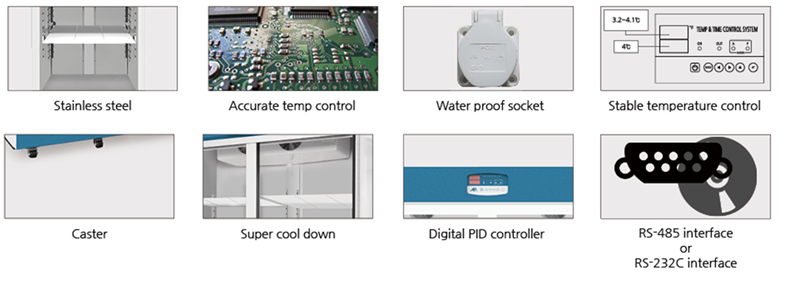
Digital Recorder - Optional

Hybrid Recorder - Optional

Vacuum Drying Oven
A vacuum drying oven is a type of drying equipment used in various industries and laboratories to remove moisture or solvents from sensitive materials at low temperatures. It operates under a reduced atmospheric pressure, typically below atmospheric pressure, which helps to lower the boiling point of liquids and accelerate the drying process without damaging the materials.
Here are some key features and applications of vacuum drying ovens:
Features:
- Vacuum Chamber: The oven has a sealed chamber that can be evacuated to create a low-pressure environment.
- Heating System: It includes heating elements that generate heat to accelerate the drying process.
- Temperature Control: The oven allows precise control of temperature to ensure optimal drying conditions for different materials.
- Vacuum Pump: A vacuum pump is used to create and maintain the desired low-pressure environment inside the chamber.
- Safety Features: Vacuum drying ovens often come with safety features like over-temperature protection and pressure relief valves to ensure safe operation.
Applications:
- Pharmaceutical Industry: Vacuum drying ovens are used to dry sensitive pharmaceutical products, such as medicines, herbal extracts, or active pharmaceutical ingredients (APIs).
- Electronics Industry: They are used to dry delicate electronic components or devices, preventing damage from excessive heat or moisture.
- Materials Research: Vacuum drying ovens are employed in materials research laboratories to dry and dehydrate samples, such as polymers, composites, or ceramics.
- Food Industry: These ovens can be used for vacuum drying of food products to extend shelf life, such as fruits, vegetables, or meat.
- Chemical Industry: Vacuum drying ovens are useful for drying heat-sensitive chemicals, solvents, or other laboratory reagents.
Overall, vacuum drying ovens offer a controlled and efficient drying process for sensitive materials by utilizing low-pressure environments. They find application in various industries and research fields where preserving the integrity and quality of the dried materials is crucial.
SH Vacuum Drying Oven SH-VDO-08NG Vacuum oven 8 liters
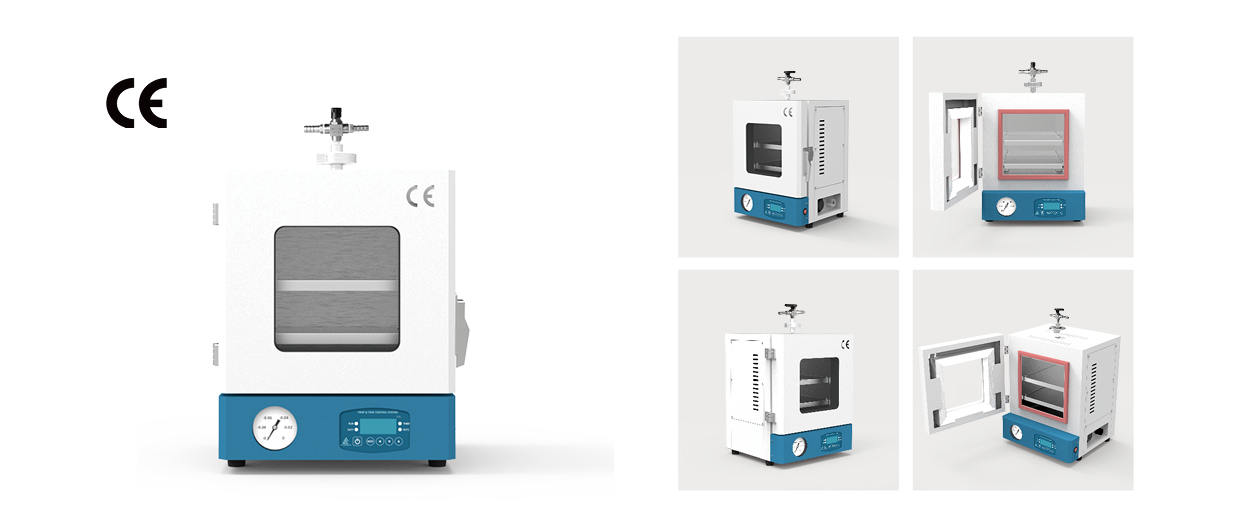
SH Vacuum Drying Oven SH-VDO-30NG Vacuum oven 27 liters
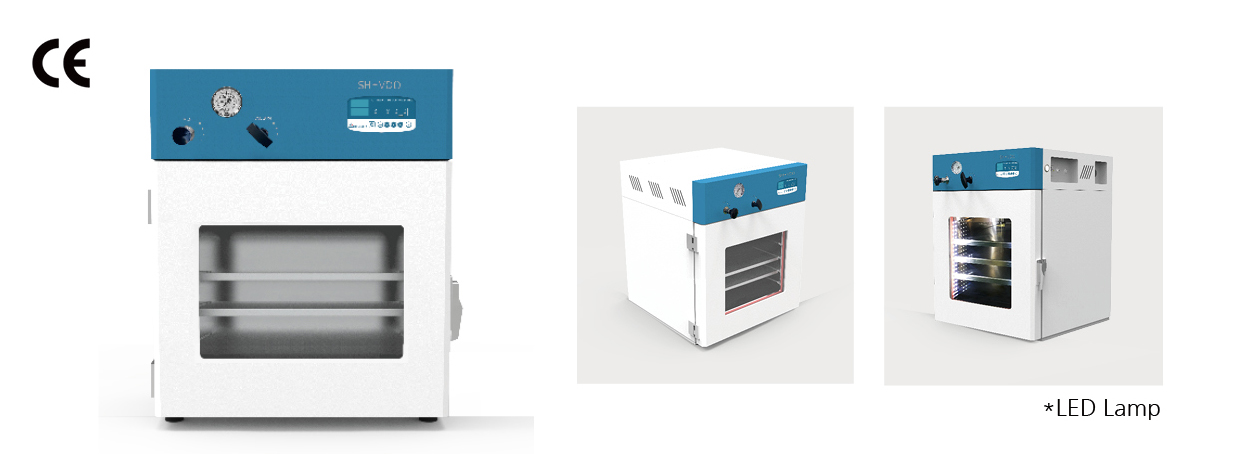
SH Vacuum Drying Oven SH-VDO-70NG Vacuum oven 64 liters
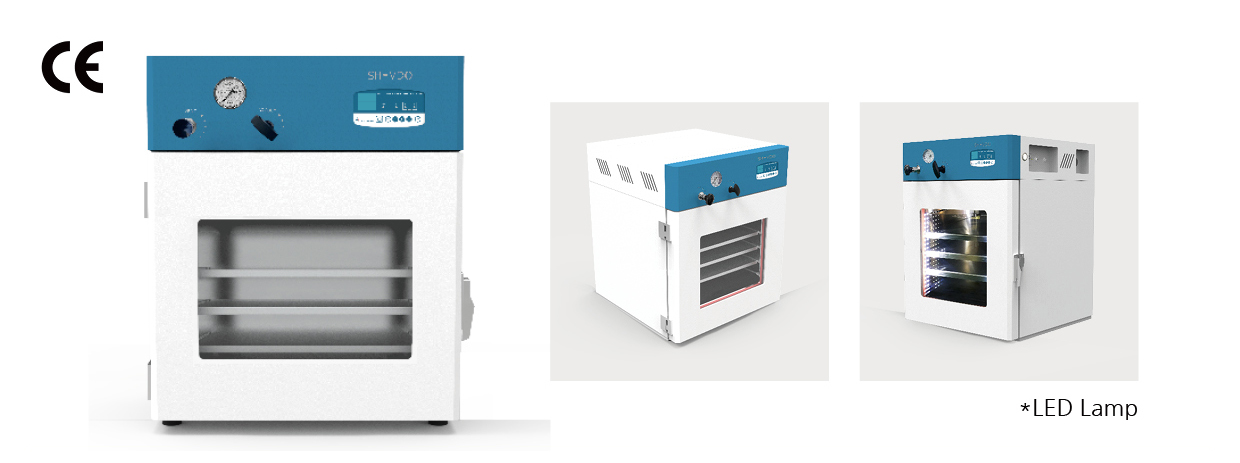
SH Vacuum Drying Oven SH-VDO-125NG Vacuum oven 125 liters
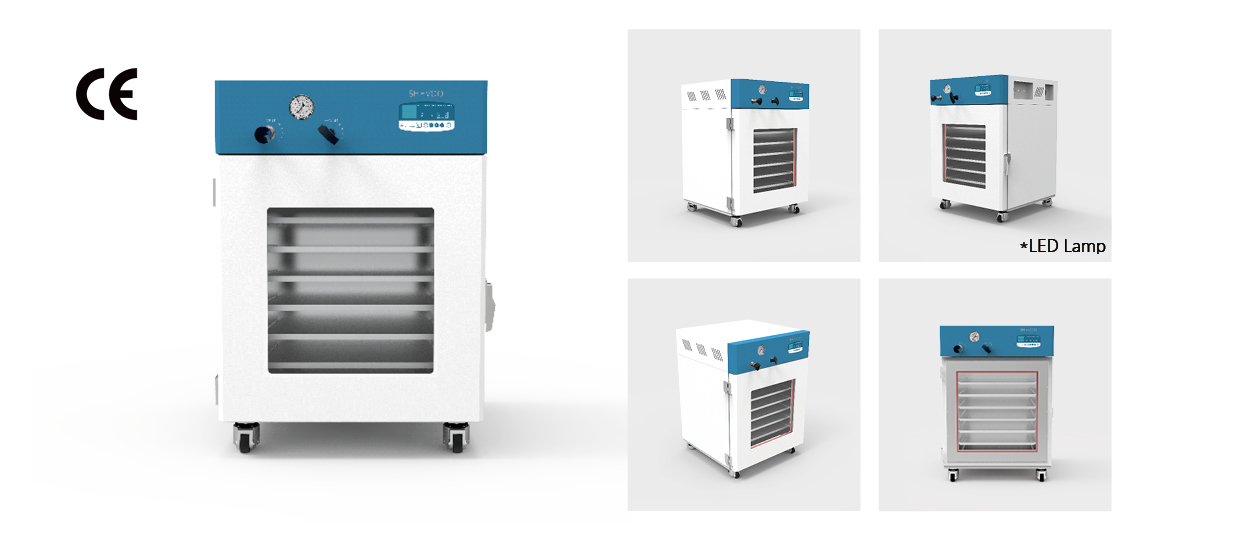
SH Vacuum Drying Oven SH-VDO-216NG Vacuum oven 216 liters
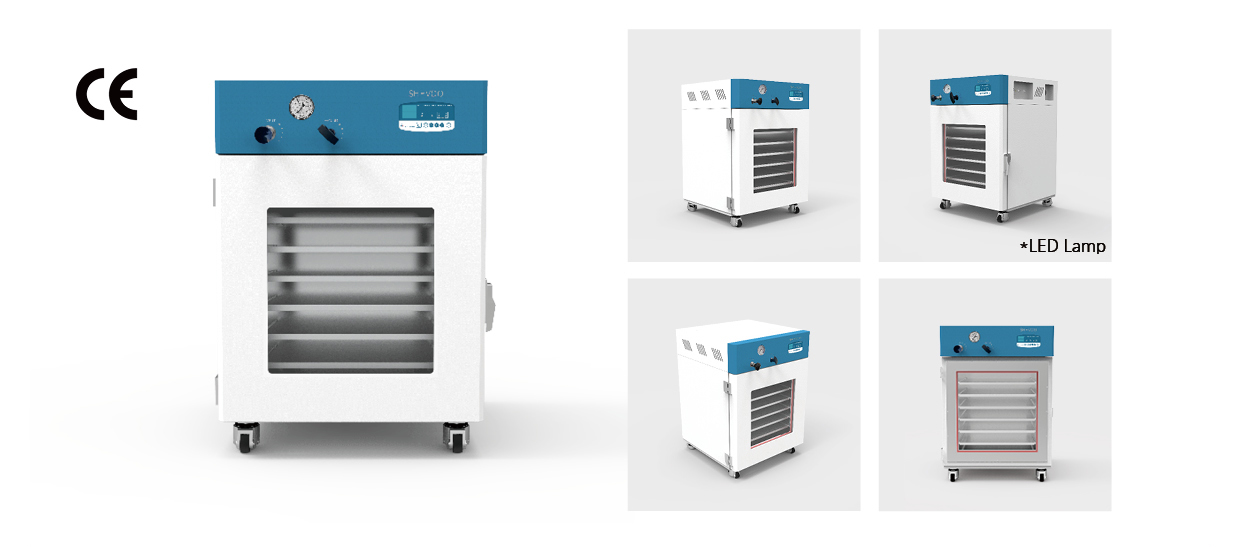
- Separated vacuum port and vent port
- Du-aluminium Shelves(Excellent heat conductivity)
- Internal observation is possible through View Window
- Excellent temperature uniformity and accuracy
- Stainless Steel Internal Chamber with shelves
- Safety assurance with C.E conformity
Vacuum Drying Oven Feature
A Vacuum Drying Oven is used for drying at low temperatures by lowering the pressure. In addition, this unit dries samples without causing residues, scaling, or oxidation. Thus, this equipment widely used in laboratories and other related industries.
- View window with spring mounted shatter proof safety glass panel
- RS-485 or RS-232C interface
- Digital PID controller
- Stainless steel & Door sealing gasket
- Steel plate with powder heating coated
- Leveling feet / caster
- Safety devices
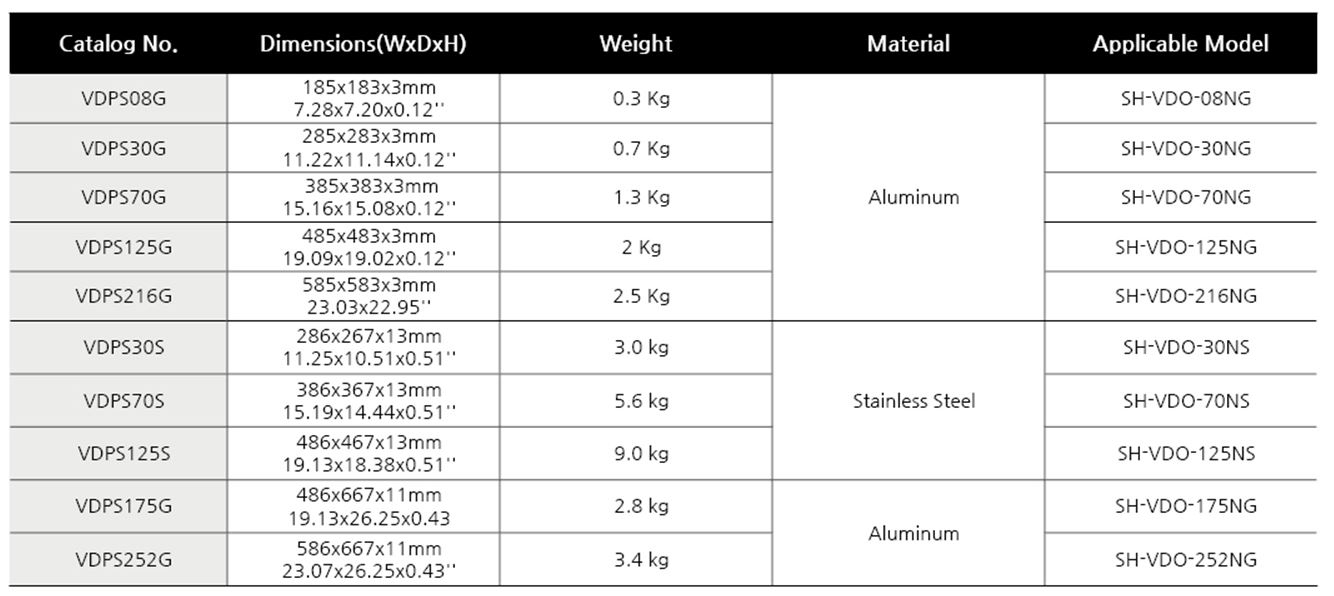
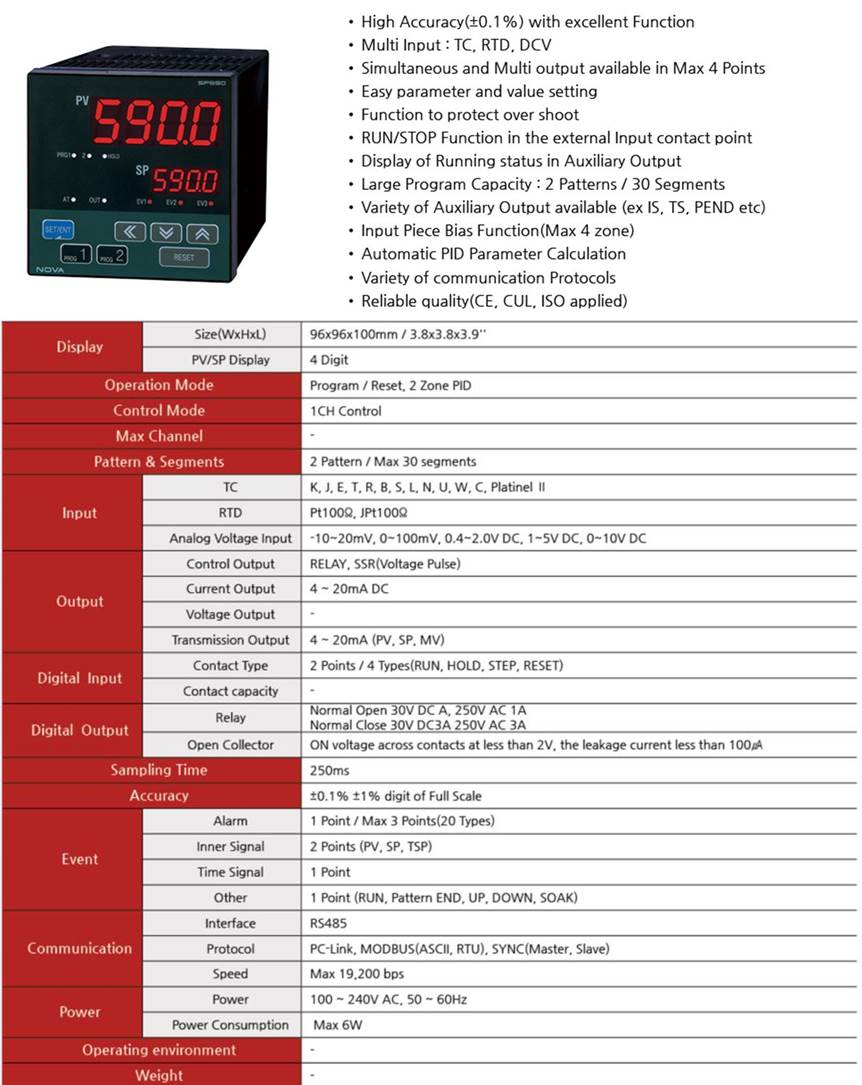
400°C Vacuum Drying Oven
A 400°C vacuum drying oven is a specific type of vacuum drying oven that is designed to operate at temperatures up to 400 degrees Celsius. This high-temperature capability allows for the drying and processing of materials that require elevated temperatures for efficient removal of moisture or solvents.
Here are some key points to understand about a 400°C vacuum drying oven:
Temperature Range: The oven can reach and maintain temperatures up to 400 degrees Celsius (or 752 degrees Fahrenheit). This higher temperature range enables the drying of heat-resistant materials or substances that have high boiling points.
Vacuum Capability: Similar to standard vacuum drying ovens, a 400°C vacuum drying oven is equipped with a vacuum system that can create and maintain a reduced pressure environment inside the drying chamber. The vacuum assists in lowering the boiling points of liquids, accelerating the drying process, and minimizing the potential for material degradation.
Heating System: To achieve and maintain the high temperatures, these ovens typically employ robust and efficient heating elements such as electric resistance heaters or sometimes infrared heating. These heating systems are designed to evenly distribute heat throughout the chamber for uniform drying.
Temperature Control: A 400°C vacuum drying oven will have precise temperature control mechanisms to accurately regulate and maintain the desired temperature. Advanced temperature control systems, such as digital controllers or programmable temperature profiles, may be included for precise temperature management.
Applications: This type of vacuum drying oven is commonly used in industries and laboratories where materials need to be dried, cured, or processed at high temperatures. Examples include heat treatment of metal components, drying of ceramics or glass, removal of solvents from high-temperature polymers, and various research or production processes in fields such as electronics, aerospace, automotive, and more.
Safety Considerations: Working with high temperatures requires careful attention to safety. 400°C vacuum drying ovens should incorporate safety features such as over-temperature protection, thermal insulation, and secure sealing mechanisms to prevent heat loss or potential hazards.
SH Vacuum Drying Oven SH-VDO-30NS Vacuum oven max temperature 450˚C 27 liters
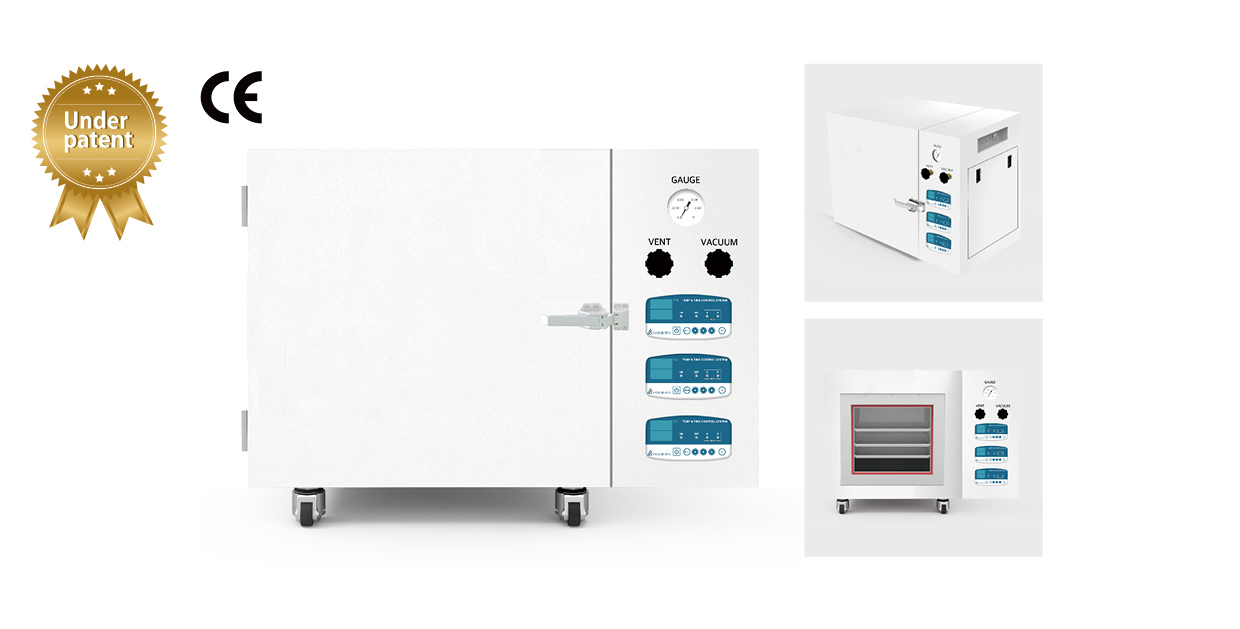
SH Vacuum Drying Oven SH-VDO-70NS Vacuum oven max temperature 450˚C 67 liters

SH Vacuum Drying Oven SH-VDO-125NS Vacuum oven max temperature 450˚C 125 liters

400˚C Vacuum Drying Oven
- Individual temperature control for each direct heating shelf (Under Patent)
- Suitable for operating temperature up to 350˚C
- Rapid heating time up to setting temperature.
- Designed to maintain stable temperature uniformity
- Safety assurance with C.E conformity
400˚C Vacuum Drying Oven Feature
Nowadays, the usage of high temperatures in testing and other industries is increasing. Thus, we produce this version of the Vacuum Drying Oven. This unit is suitable for samples that need to operate on a temperature as high as 400˚C. This unit can also be used in case of drying samples without causing residues, scaling or oxidation.
- Each shelf heating control function
- Digital PID controller
- Stainless steel inner chamber & Door sealing gasket
- Steel plate with powder heating coated
- Leveling caster
- Individual Direct Heating Shelves
- Stainless steel Pipe & Connector & Valve


Precision Temp Control Vacuum Drying Oven
A precision temperature control vacuum drying oven is a specialized type of vacuum drying oven that offers precise and accurate temperature control during the drying process. This type of oven is designed to maintain a stable and uniform temperature throughout the drying chamber, ensuring consistent and reliable results.
Here are some key features and benefits of a precision temperature control vacuum drying oven:
Temperature Accuracy: These ovens are equipped with advanced temperature control systems that provide high accuracy and stability. They often use microprocessor-based controllers or digital temperature controllers to regulate and monitor the temperature inside the chamber.
Uniform Heating: The oven's heating system is designed to distribute heat evenly throughout the chamber, minimizing temperature variations and ensuring uniform drying of the materials. This feature is particularly important when working with sensitive or delicate samples.
Programmable Settings: Many precision temperature control vacuum drying ovens allow users to program and store specific temperature profiles or drying cycles. This feature is beneficial when following standardized drying protocols or conducting repetitive experiments.
Sensor Technology: These ovens may incorporate advanced sensors, such as platinum resistance temperature detectors (RTDs) or thermocouples, to accurately measure the temperature inside the chamber and provide real-time feedback to the temperature control system.
Safety Features: Precision temperature control vacuum drying ovens often include safety features such as over-temperature protection, alarms, and automatic shutdown mechanisms to prevent overheating and ensure user safety.
Data Logging and Connectivity: Some advanced models of precision temperature control vacuum drying ovens offer data logging capabilities, allowing users to record and monitor temperature data during the drying process. Additionally, they may feature connectivity options, such as USB ports or Ethernet connections, for data transfer or remote control.
These features make precision temperature control vacuum drying ovens well-suited for applications where maintaining precise temperature conditions is critical. Industries such as pharmaceuticals, electronics, materials research, and food production can benefit from these ovens to achieve accurate and reproducible drying results while ensuring the integrity of sensitive materials.
SH Vacuum Drying Oven SH-VDO-175NG Vacuum oven 175 liters
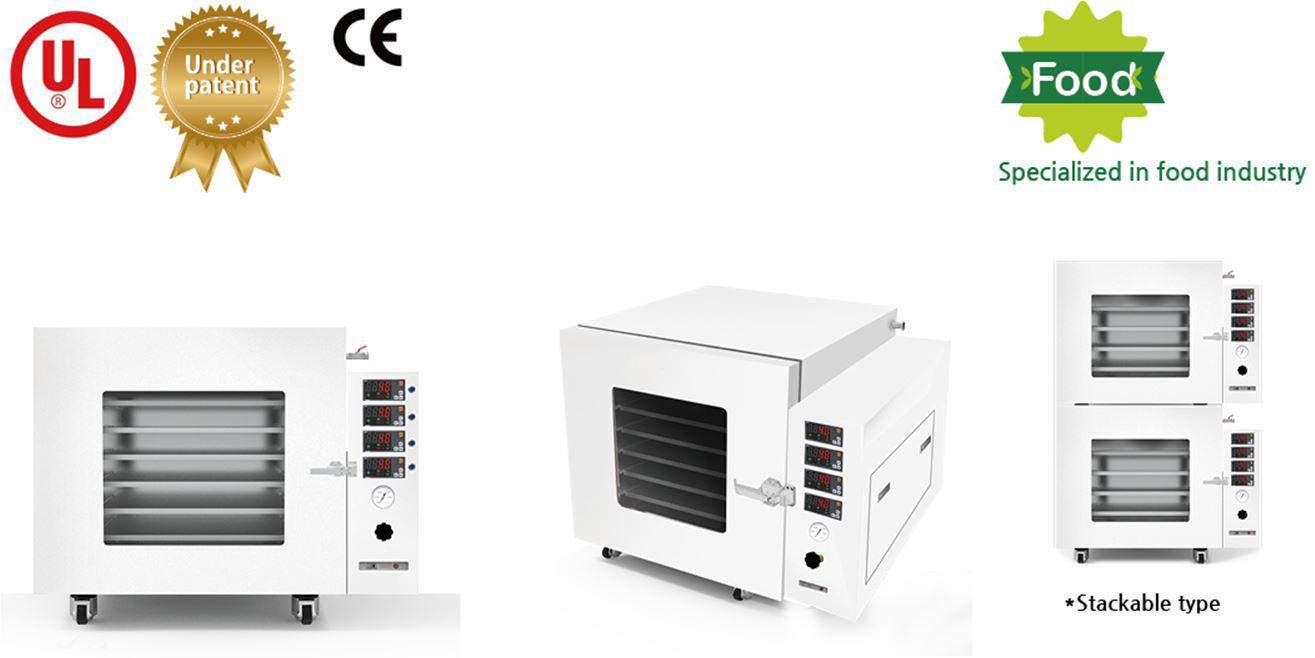
SH Vacuum Drying Oven SH-VDO-252NG Vacuum oven 252 liters
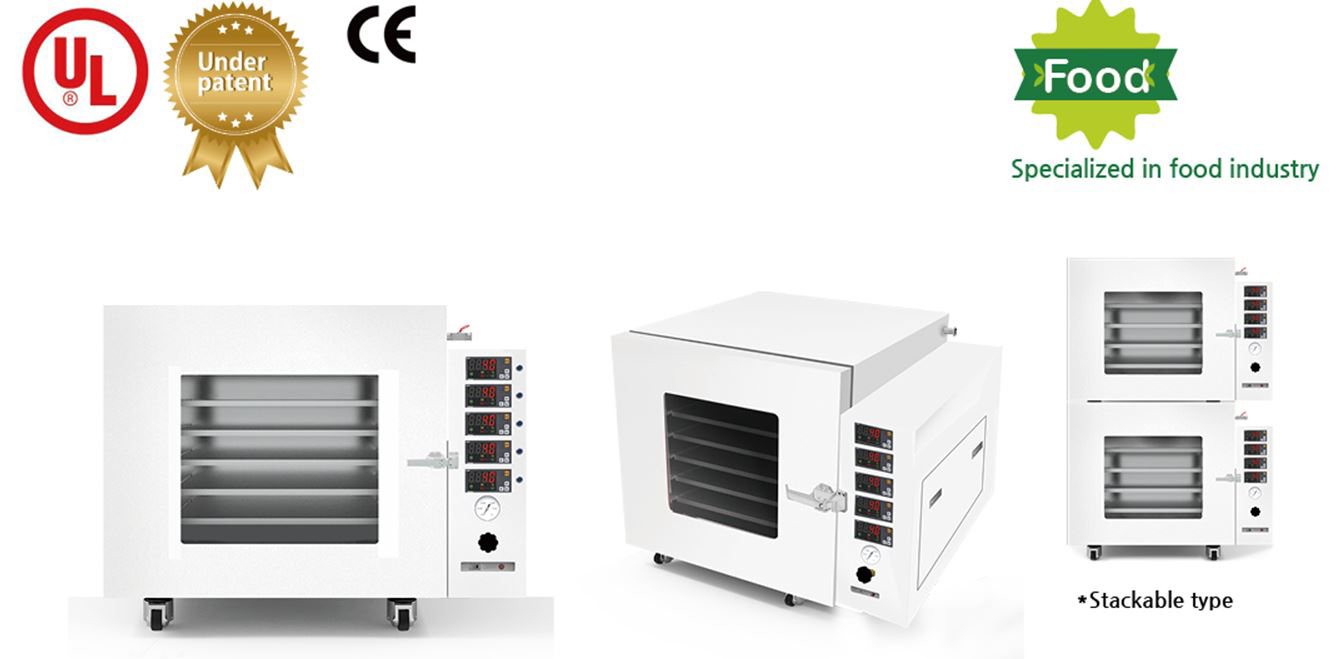
SH Vacuum Drying Oven SH-VDO-96NG Vacuum oven 96 liters
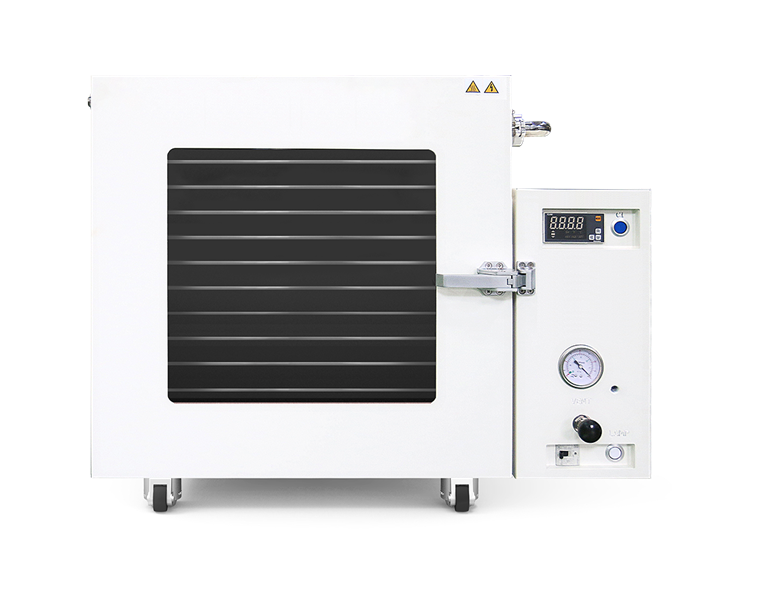
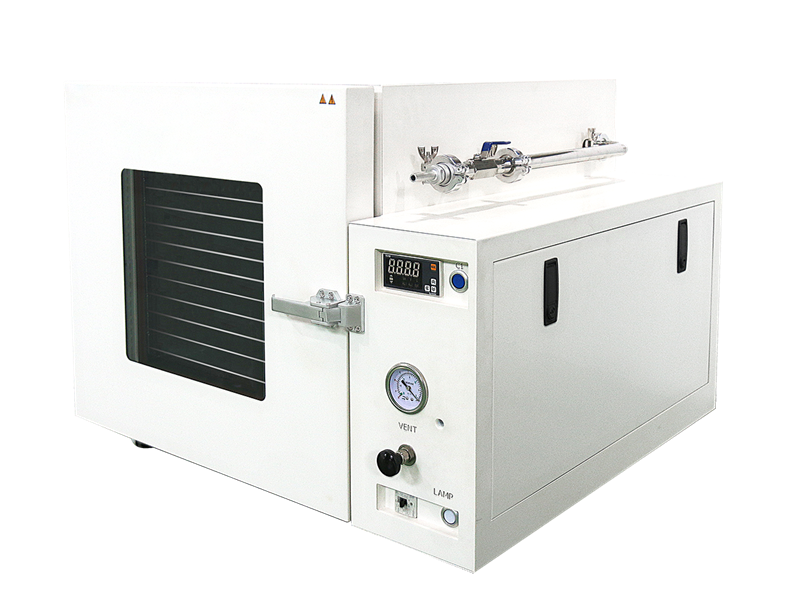
Precision Temp Control Vacuum Drying Oven
- Individual precision temperature control for each direct heating shelf (Under Patent)
- Specialized in food industry with perfect application of precision drying process
- Rapid heating time up to setting temperature.
- Designed to maintain stable temperature uniformity
- Safety assurance with UL and CE conformity
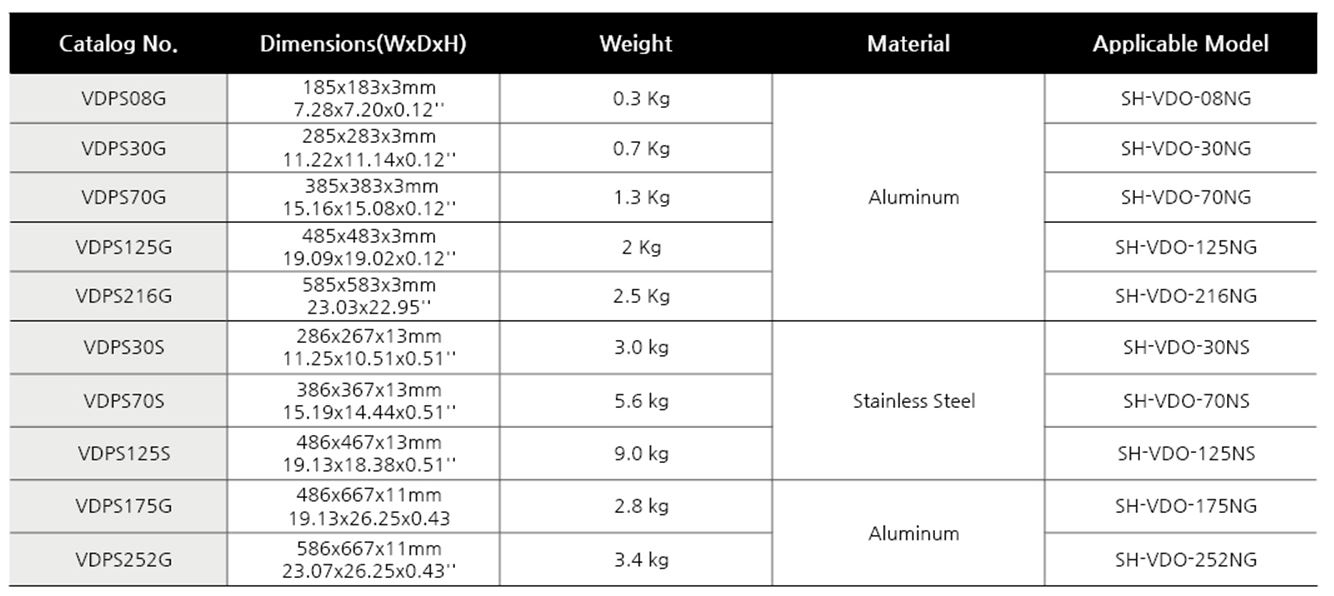
Precision Temp Control Vacuum Drying Oven Package
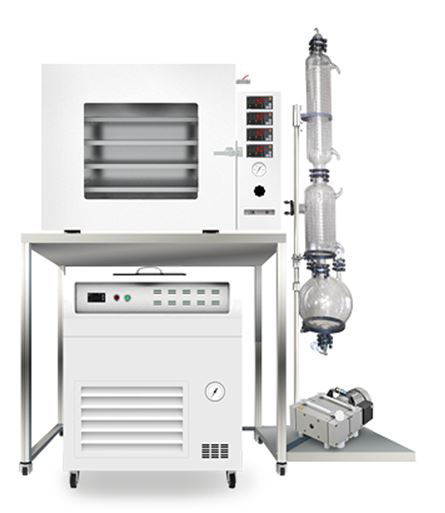

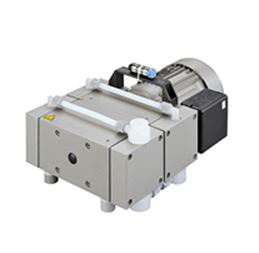
Vaccum Oven Package
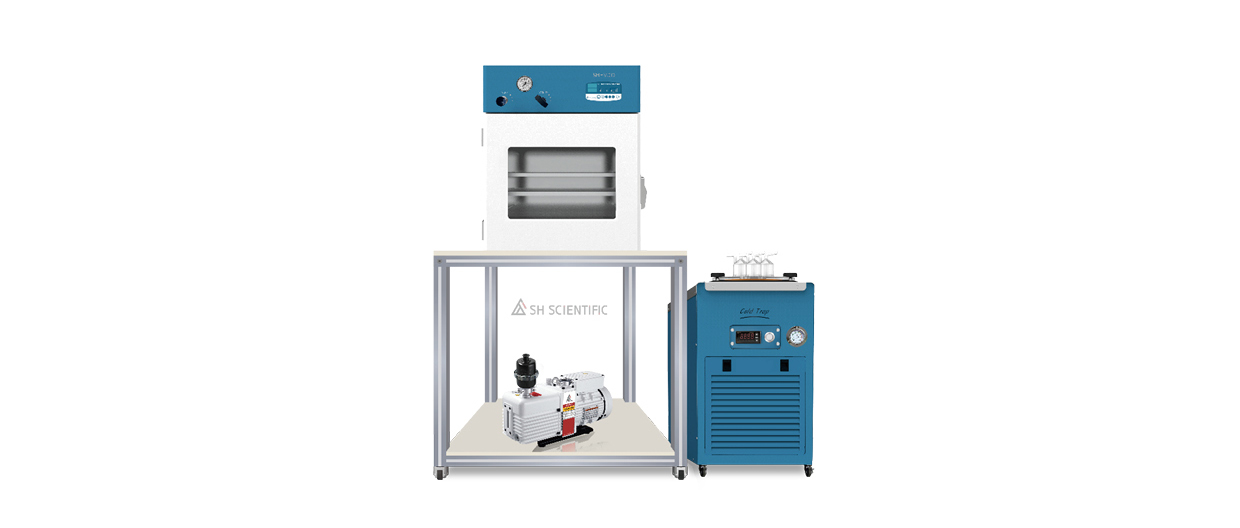
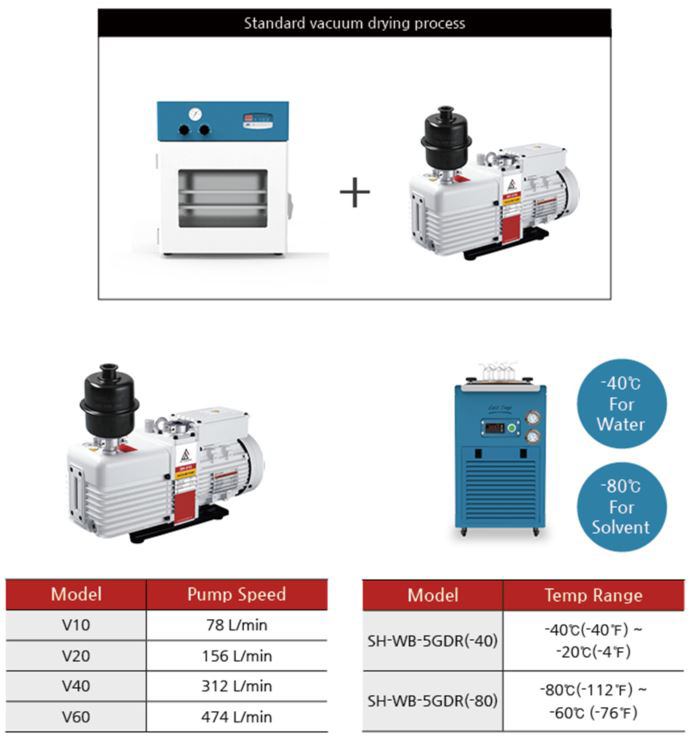
Cold Trap Bath
A cold trap bath, also known as a cold trap or cryogenic trap, is a device used to capture and condense volatile substances, such as vapors or gases, by cooling them to very low temperatures. It is commonly used in vacuum systems or distillation setups to prevent the migration of unwanted vapors or contaminants into the vacuum pump or further along the system.
Here are some key features and functions of a cold trap bath:
Cooling Mechanism: A cold trap bath uses a cooling medium, typically a cryogenic liquid such as liquid nitrogen or liquid helium, to achieve very low temperatures. The cooling medium is circulated within the bath to maintain a constant low temperature.
Trap Design: A cold trap bath usually consists of a cylindrical or spherical vessel that holds the cooling medium. The vessel is equipped with an inlet and outlet for the flow of gases or vapors. The gases or vapors pass through the cold trap, where they are cooled and condensed.
Condensation of Vapors: When the volatile substances come in contact with the cold surface of the trap, they lose heat and undergo condensation. The condensed substances then accumulate in the trap, preventing them from reaching the vacuum pump or other components of the system.
Prevention of Contamination: Cold trap baths are effective in preventing contamination of vacuum systems by capturing volatile compounds, solvents, or undesired byproducts. They help maintain a clean and efficient vacuum environment.
Application Specific: Cold trap baths can be tailored to specific applications based on the cooling medium used, the size and design of the trap, and the type of substances being captured. Different trap designs and cooling mediums may be selected depending on the temperature requirements and the nature of the vapors or gases to be trapped.
Maintenance: Cold trap baths require periodic maintenance to remove the accumulated condensed substances. This involves thawing or warming the trap to release the trapped materials or replacing the cooling medium if necessary.
Cold trap baths are widely used in various scientific and industrial applications. Some common applications include:
Vacuum systems: They are employed in vacuum pumps, freeze drying, and vacuum distillation setups to prevent the migration of vapors or contaminants into the pump or distillation apparatus.
Analytical instruments: Cold trap baths are utilized in gas chromatography (GC) or mass spectrometry (MS) systems to remove unwanted impurities or moisture from the sample.
Solvent recovery: They can be used to recover and condense volatile solvents, minimizing waste and reducing environmental impact.
Overall, cold trap baths are valuable tools for capturing and condensing volatile substances, protecting vacuum systems, and maintaining clean and efficient processes in various scientific and industrial applications.
SH Cold Trap Bath SH-WB-5GDR (-40℃)
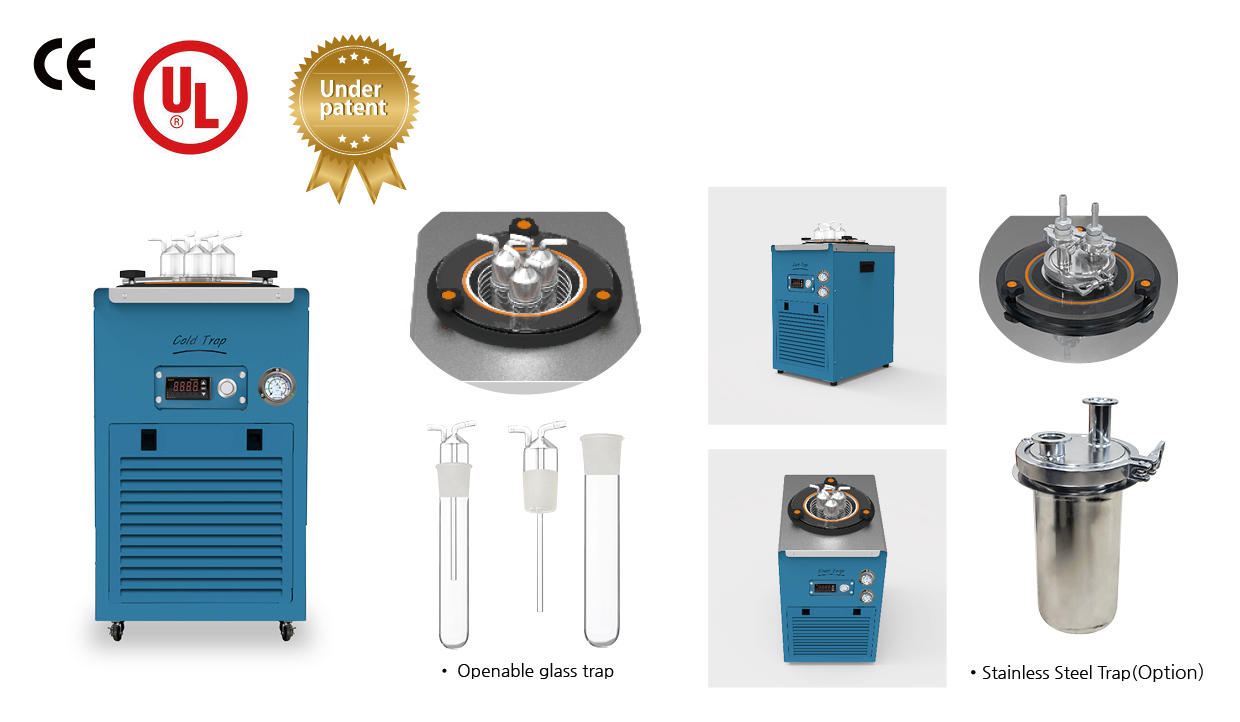
SH Cold Trap Bath SH-WB-5GDR (-80℃)
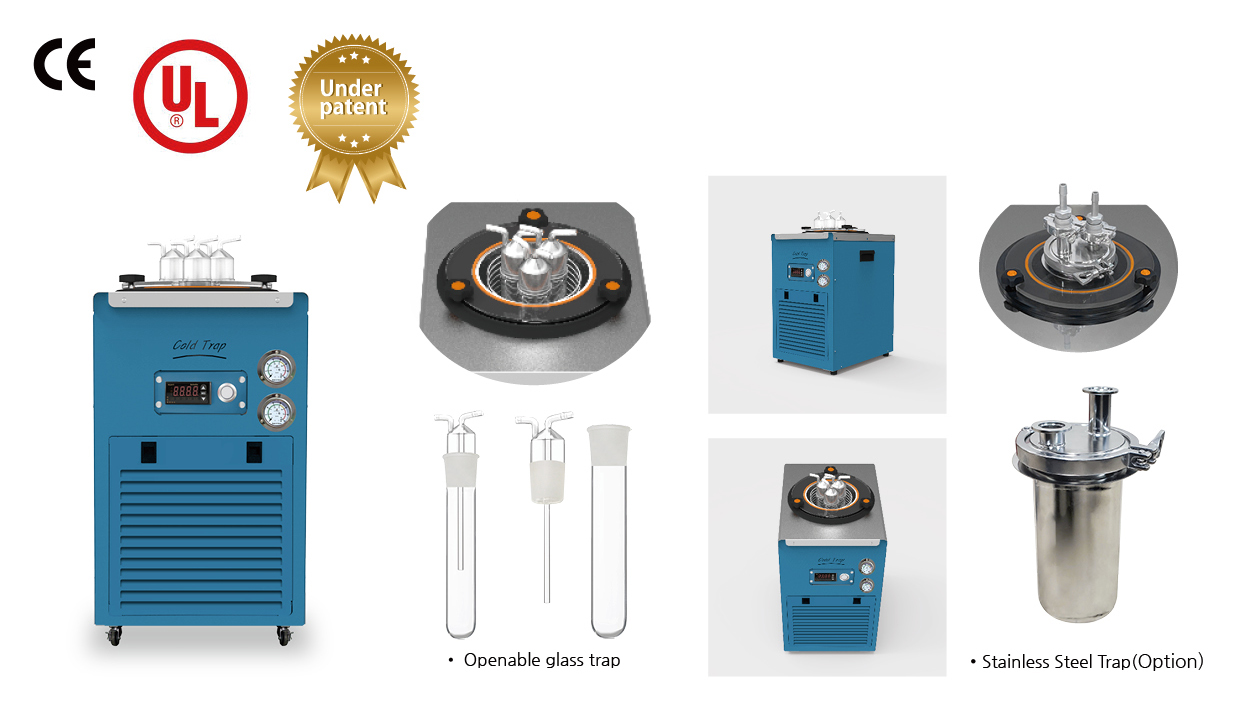
SH Cold Trap Bath SH-WB-5GDR (-20℃)

Cold Trap Bath
- Digital temp controller type (convenient to check the teperature status)
- 3 Glass Trap installation
- Upside opended Glass Trap
- Seamless structure bath to prevent leakage of anti-freeze
- Easy internal observation with Transparent Cover
*Important Notice
Ethylene glycol or anti-freezer is recommended. But they should be sloopy and runny enough, otherwise it will affect the performance of cooling. Heat transfer fluid is also recommended in case of cryogenic products.
Cold Trap Bath Feature
In vacuum applications, a cold trap is a device that condenses all vapors(except the permanent gases) into a liquid or solid. The main purpose is to prevent vapors being produced by an experiment from entering then vacuum pump where thy would condense and contaminate it. Cold traps can also cool surfaces or baffles to prevent oil vapors flowing from a pump into a chamber.
In such a case, a baffle or section of pipe containing a number of cooled vanes, will be attached to the inlet of an existing pumping system.
- Digital controller
- Openable 3 glass trap
- Rust-free stainless coil
- Openable glass trap

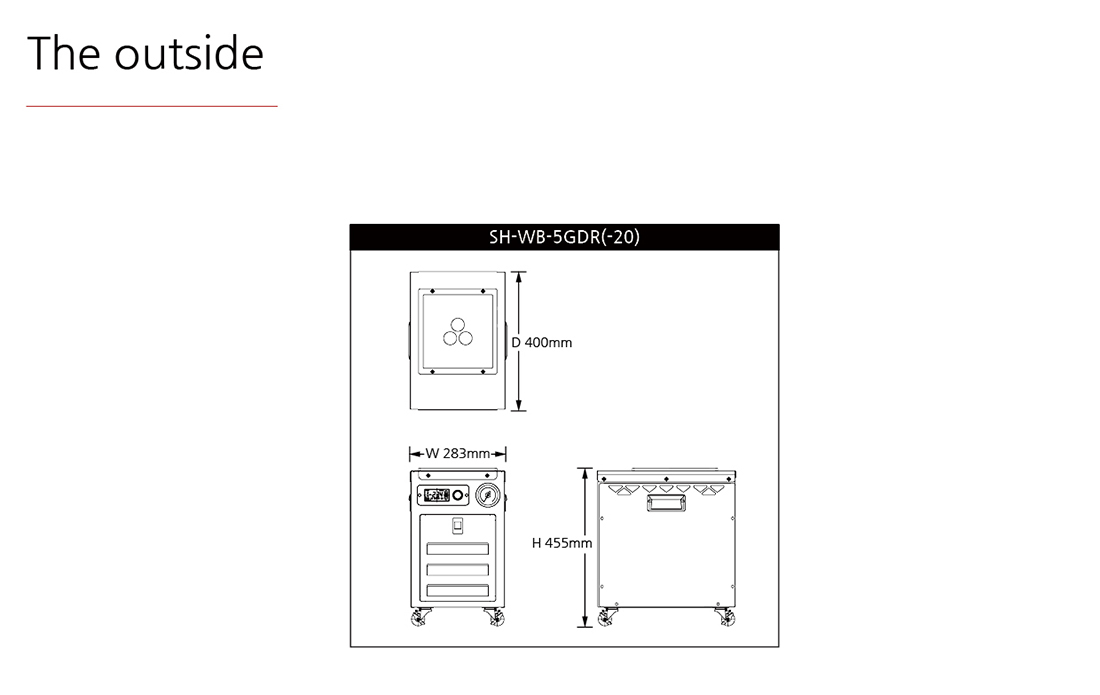
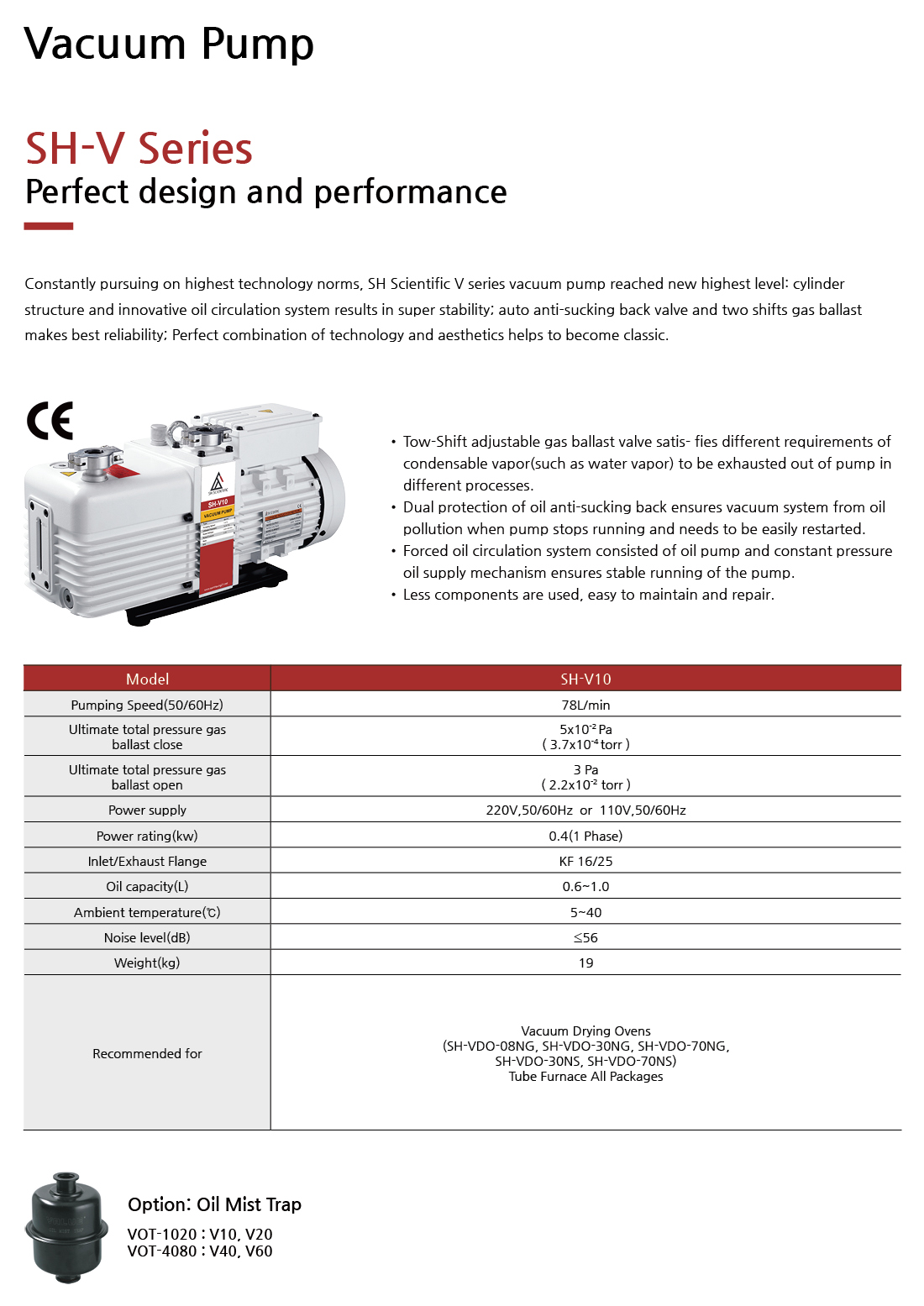
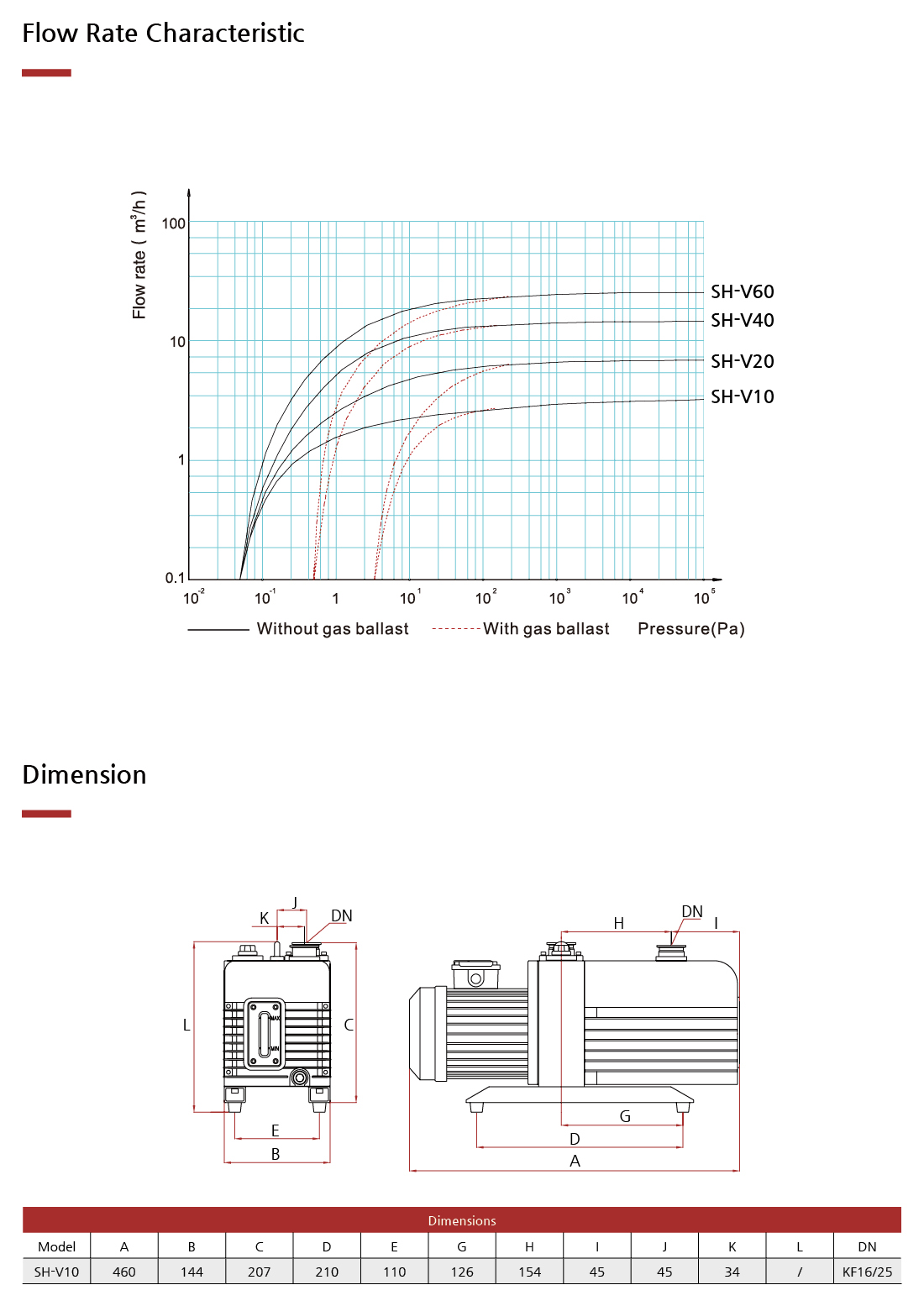
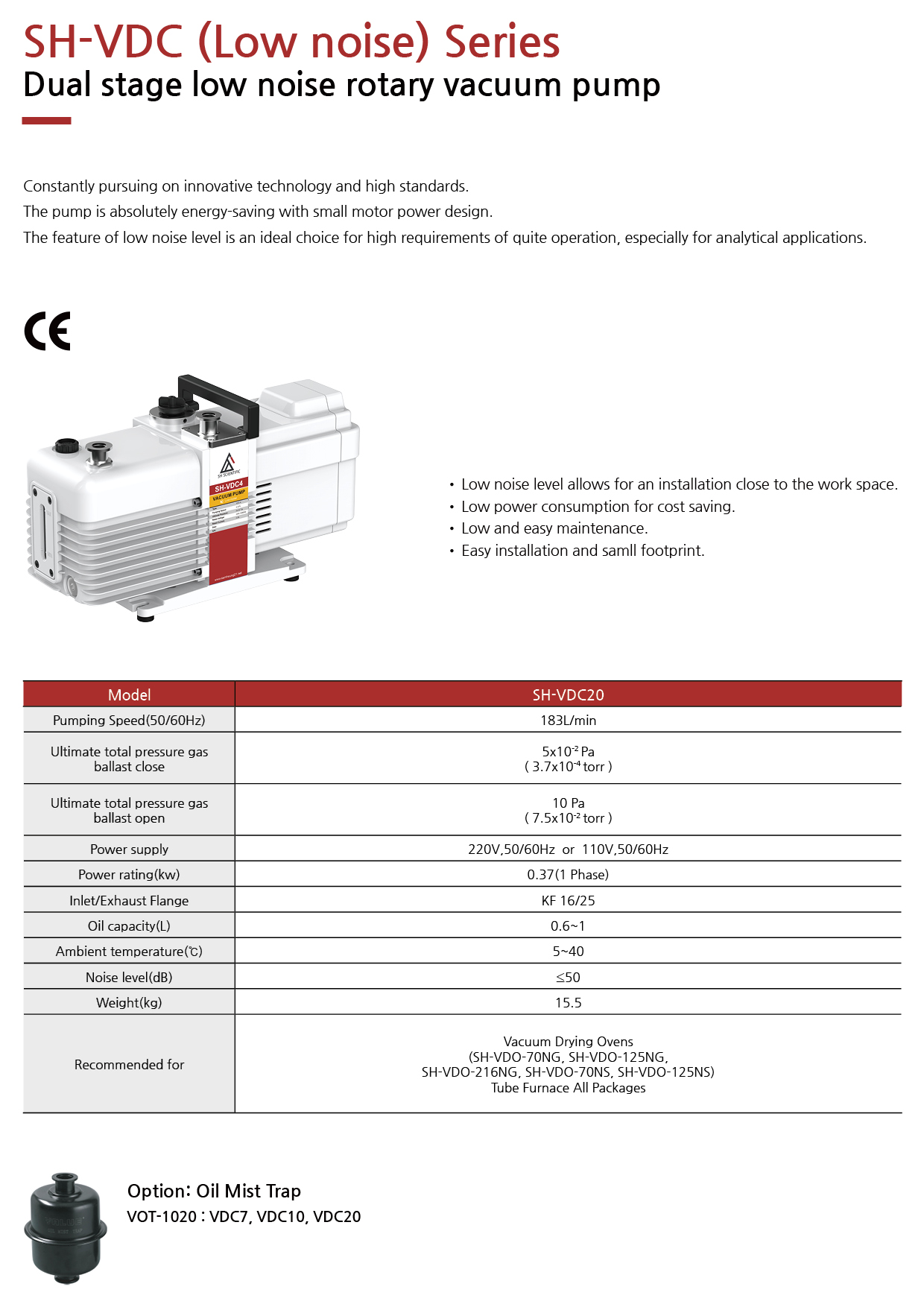
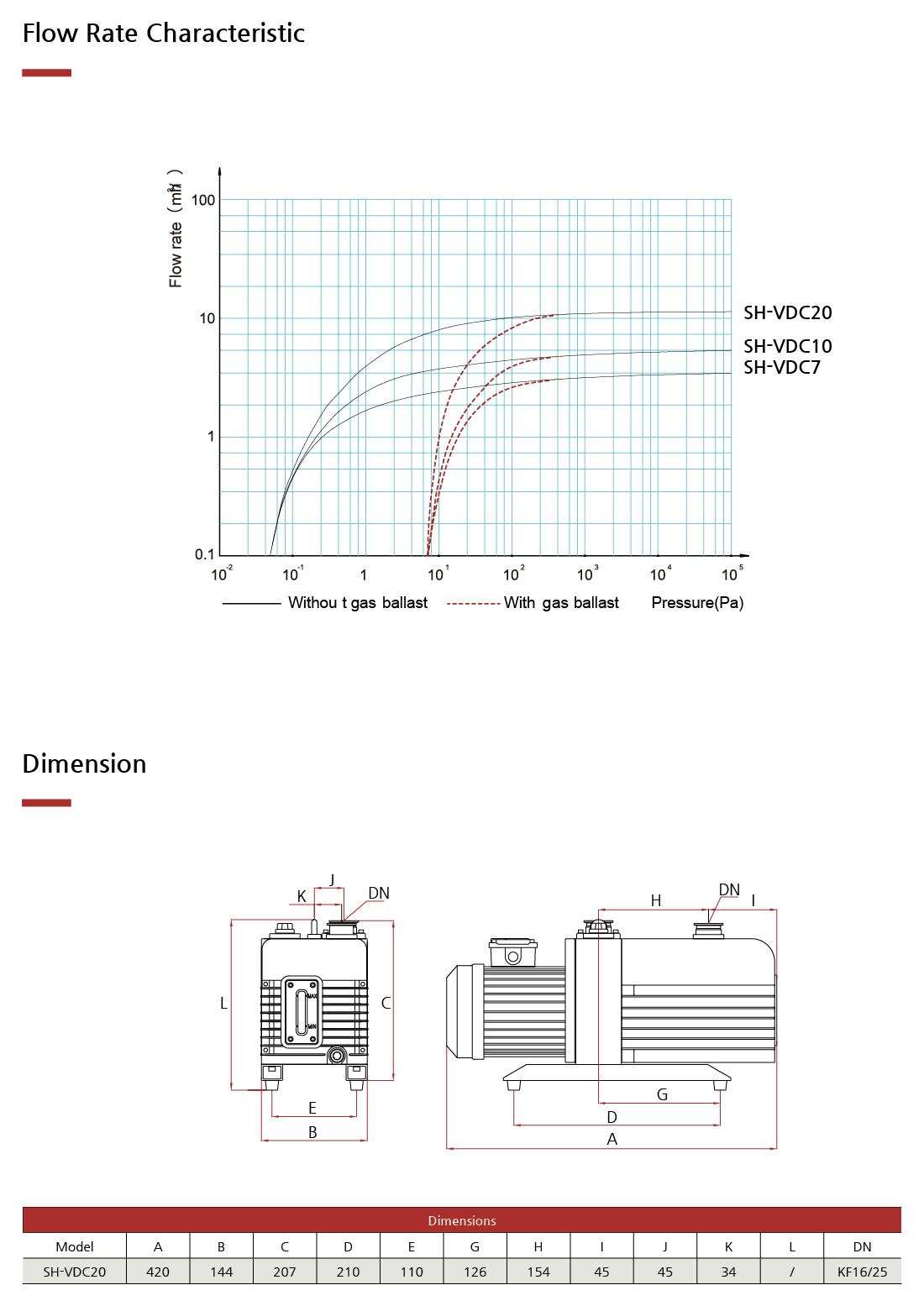
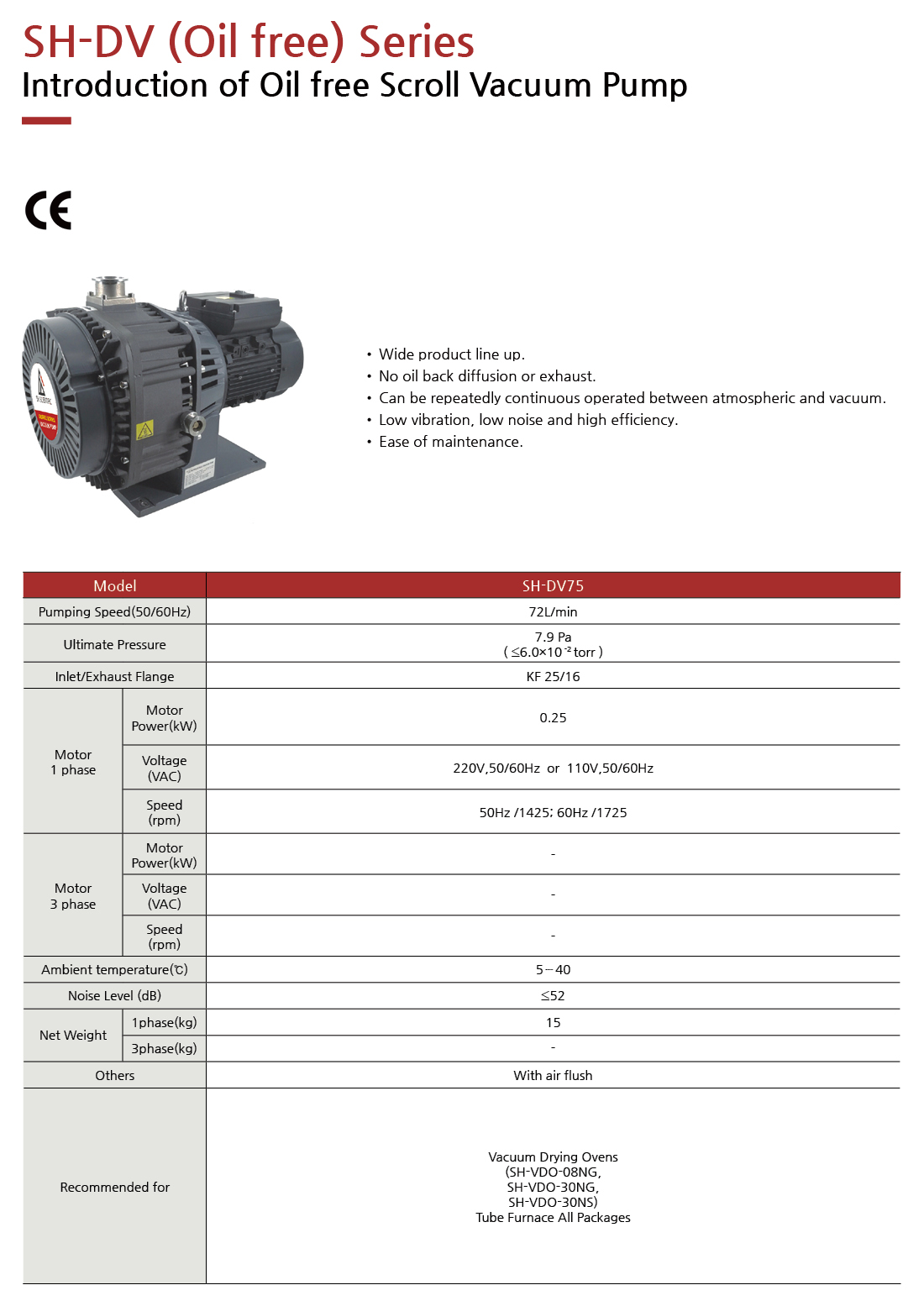

High Vacuum Pump Diffusion or Turbo Molecular Pump

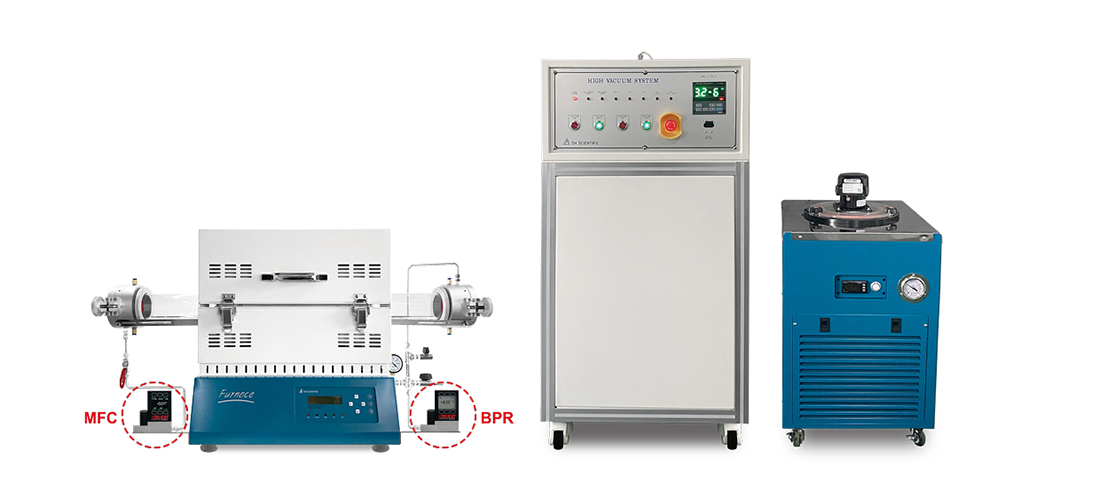
Furnace
A furnace, also known as a laboratory furnace or research furnace, is a specialized piece of equipment used in scientific research, industrial applications, and various laboratory settings. It is designed to provide controlled high-temperature environments for heating, calcination, sintering, annealing, or other thermal processes.
Scientific furnaces are commonly used in fields such as materials science, chemistry, physics, geology, and metallurgy. They are utilized for tasks like the synthesis of new materials, characterization of materials under extreme conditions, heat treatment of samples, and testing the properties of materials at high temperatures.
These furnaces typically feature advanced temperature control mechanisms, insulation to minimize heat loss, and precise heating elements such as resistance wires or heating coils. They can reach and maintain high temperatures, ranging from a few hundred degrees Celsius up to several thousand degrees Celsius, depending on the specific furnace model and application.
Scientific furnaces come in various configurations, including box furnaces, tube furnaces, muffle furnaces, vacuum furnaces, and more. Each type is designed to accommodate different sample sizes, shapes, and experimental requirements. They may also offer additional features like programmable temperature profiles, gas atmospheres, rapid heating/cooling rates, and integrated monitoring systems for data acquisition.
Muffle Furnace
- Economic muffle furnace with flap door
- General laboratory use and ashing process
- Recommended ideal running temperature is below 850℃
- Heating from 3 sides
- Excellent outgassing thanks to the exhaust air outlet on the head of chamber, i.e plastic polymer
- Single housing
- Ceramic fiber materials which are not classified as carcinogenic
- Light weight
- Prompt heat up and good maintaining
- SSR operation and PID control provides low noise operation and precise temp control (+/-1℃)



Vacuum Furnace
- Recommended ideal running temperature is below 1000°C
- Complete atmospheric control for non-oxidation environment
- Creating multiple atmospheric enviroment (burning in air, purging air and pulling vacuum, flowing inert gas and sintering)
- No limitation on samples sizes due to squre inner chamber compared to the ones with tube furnace
- Supporting hardening, annealing, tempering, brazing and sintering with or without vacuum.
- Consist of individual 4 port for vacuum, vacuum release, gas in and gas out
- An optional MFC(Mass Flow Controller) for precise, responsive and stable gas management across 98 inert gas presets
- An Optional BPR(Back Pressure Regulator) to maintain positive pressure inside the chamber
- Offering full configration with vacuum pump, MFC, BPR, Digital vacuum meter as optional for perfect & precise experiment.

Elevator Furnace
- General furnace with elevating mechanism
- General laboratory use with user safety
- Elevator furnaces are ideal for reduction, calcination, sintering, application of coatings, and other processes. SH Scientific system provides superior temperature uniformity, boasts energy efficient insulation, and delivers an ultra-pure atmosphere to process materials with minimal gas consumption.



Tube Furnace
- High temp tube furnace with hinged door
- Double housing and low surface temperature
- Recommended ideal running temperature is below 1350℃
- Great durability thanks to SIC heating element and easy replacement
- R type thermocouple
- Suitable for gas exchange experiment
- Light weight and prompt heat up thanks to ceramic insulation
- Convenient design for sample loading
- Built in programmable controller. 5 patterns and 9 segment/pattern. Total 45 segments
- Built in over temp protector
- SCR operation and built in programmable controller provides low noise operation and precise temp control (+/-1℃)
- Wide choice of applicable tube sizes. 50/80/100/120mm diameter.
- Wide choice of tube materials. Quartz, ceramic, alumina and alloy




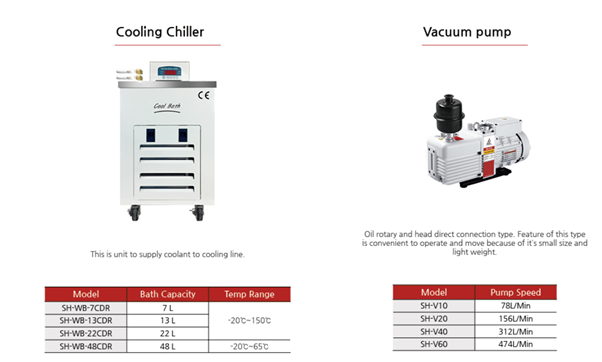
Progammable Controller
- LCD Display
- Program mode, Standard Mode Selectable.
- Parameter setting
- Auto tune function
- Timer function
- PV,SV can be displayed together


